

THE FUTURE

























For decades, we’ve delivered innovative, more powerful, and more portable duct cleaning equipment. Our latest breakthrough, the BrushBeast DR Black Edition, represents the pinnacle of this commitment. When you choose Rotobrush, you’re choosing proven performance and industry leading technology.







Experience






Four ultra-powerful motors deliver the strongest suction in Rotobrush history. UNMATCHED VACUUM POWER
ROTATION CONTROL
Personalized cleaning settings for all duct types, including delicate flex ducts.




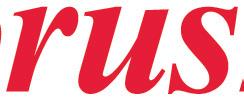




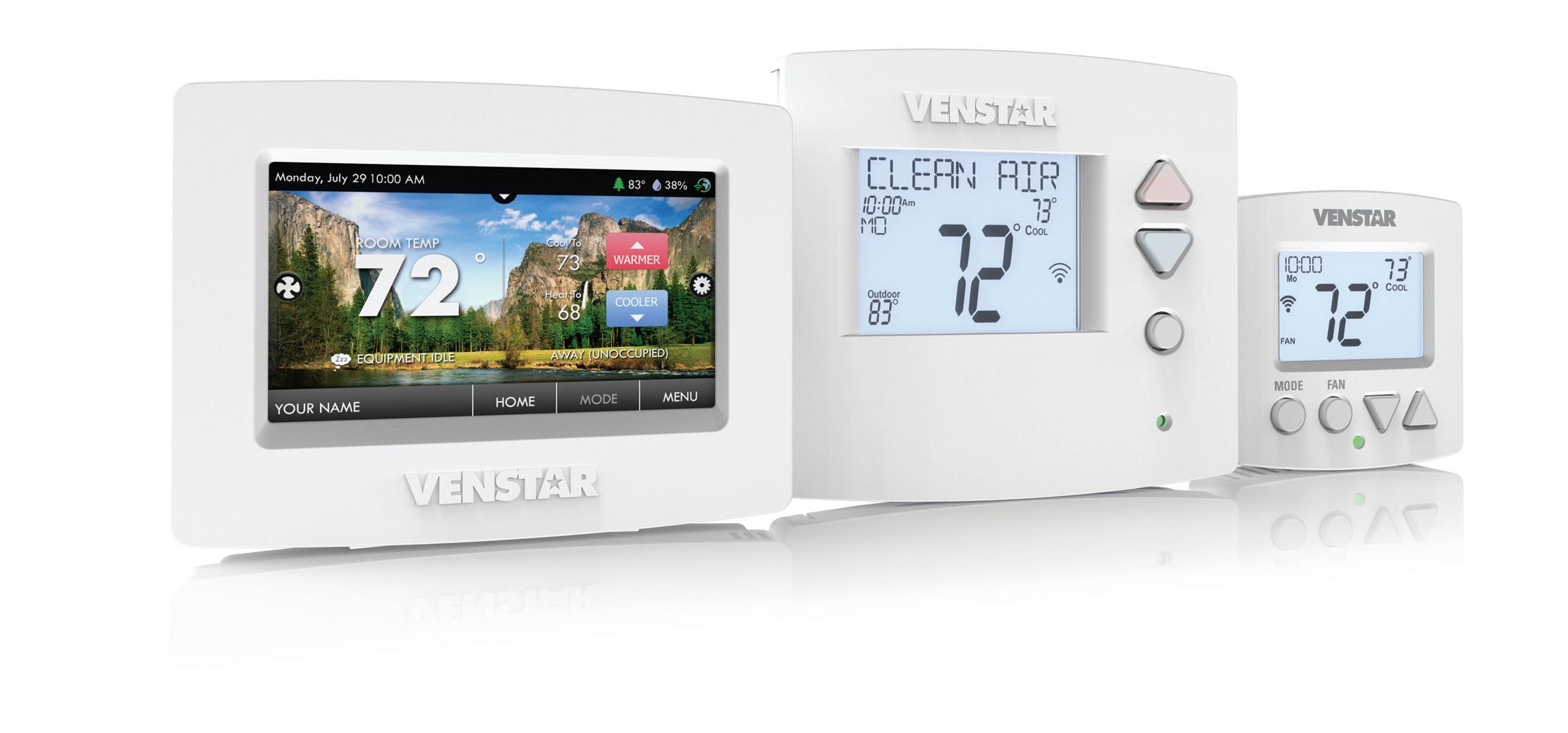
Innovative thermostats that raise the bar for connected features and value.
• Professional, contractor grade
• Residential, Commercial, and School models
• Easy to install, simple to program
• Can help reduce energy costs

• Reliable, feature rich, and better value
• Free Skyport Mobile App controls comfort from virtually anywhere
• Advanced geofencing, reporting, and alerts







AI is quickly becoming a practical tool in the HVACR industry.

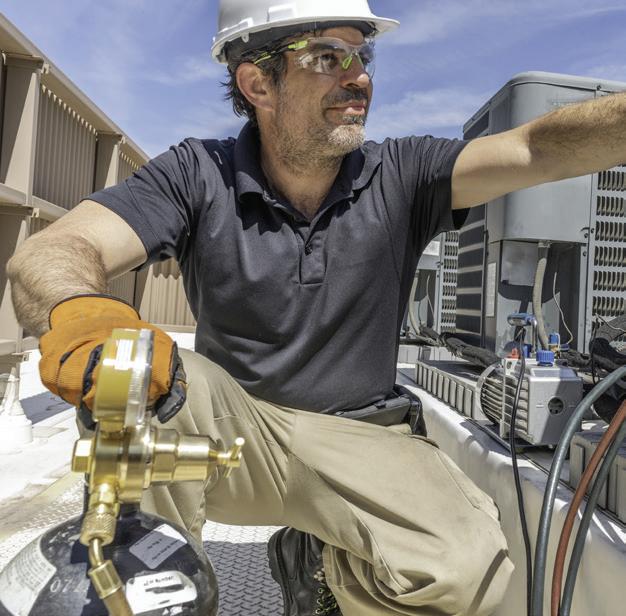
Mobile Tech Aids HVAC Contractor in Texas Flood Response
To the T Plumbing, Heating & Air leveraged Housecall Pro’s mobile app to maintain operations during the historic July flood.


The









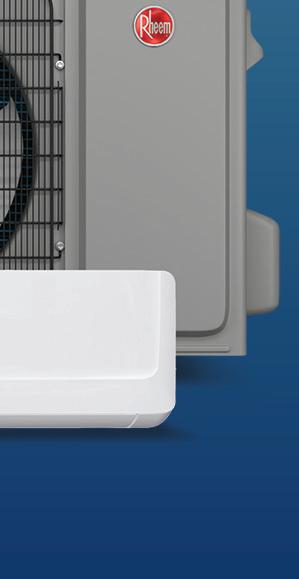
A Roadmap to Retaining and Growing Multigenerational Teams
In this episode, Trevor Bacon of Bacon Plumbing, Heating, Air & Electric shares proven strategies for engaging and retaining HVAC talent across multiple generations. www.contractingbusiness.com/55315449

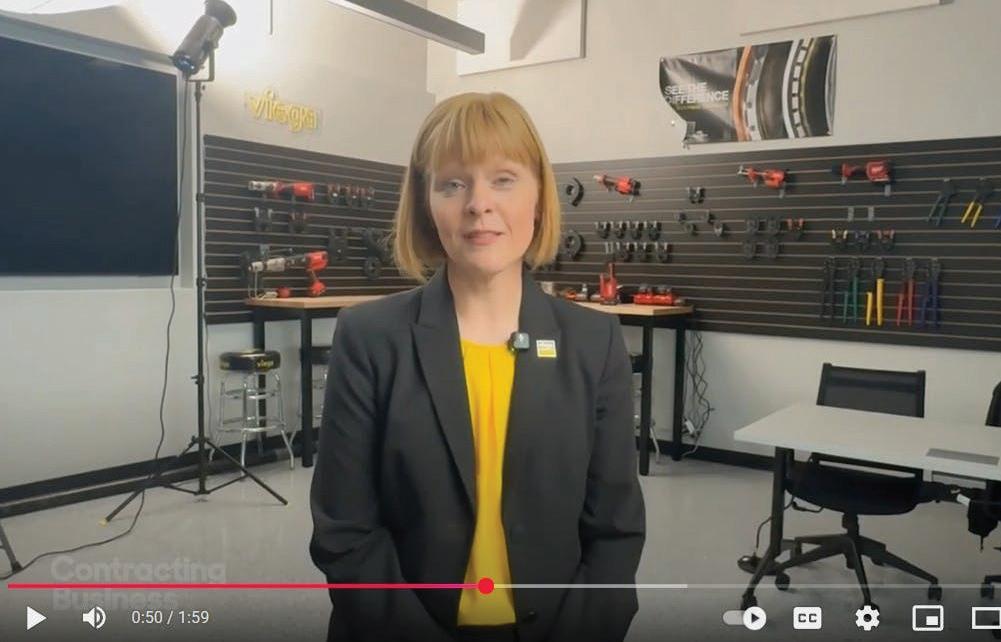
Inside Viega’s $178M Carbon-Neutral Manufacturing & Training Facility
Viega North America officially opened its new $178M, 244,000-square-foot manufacturing and training facility in Mantua, Ohio on Sept. 4. www.contractingbusiness.com/55316092



VP/Market Leader - Buildings & Construction Group, Mike Hellmann
Group Editorial Director
Buildings & Construction, Mike Eby
Editor-In-Chief, Nicole Krawcke, nkrawcke@endeavorb2b.com
Art Director, Julie Whitty
Production Manager, Sam Schulenberg
Audience Development Manager, James Marinaccio, jmarinaccio@endeavorb2b.com
Ad Services Manager, Deanna O’Byrne
Viega North America CEO Shares Vision Behind New Ohio Manufacturing Expansion
Marki Huston discusses how the Mantua, Ohio facility aligns with Viega's strategic growth plans and enhances service and innovation in the U.S. market.
www.contractingbusiness/55317800

How Well Do You Know the International Mechanical Code?
Staying sharp on code requirements is key to keeping your projects safe, compliant, and efficient. Test your knowledge and challenge yourself in our monthly quiz on the IMC.
www.contractingbusiness.com/55313153
CEO, Chris Ferrell
COO, Patrick Rains
CRO, Paul Andrews
CDO, Jacquie Niemiec
CALO, Tracy Kane
CMO, Amanda Landsaw
EVP Building & Construction Group Chris Perrino
Contracting Business (USPS Permit 010-480, ISSN 0279-4071 print, ISSN 2771-652X online) is published monthly by Endeavor Business Media, LLC, 201 N. Main St., 5th Floor, Fort Atkinson, WI 53538. Periodicals postage paid at Fort Atkinson, WI, and additional mailing offices. POSTMASTER: Send address changes to Contracting Business , PO Box 3257, Northbrook, IL 60065-3257. SUBSCRIPTIONS: Publisher reserves the right to reject non-qualified subscriptions. Subscription prices: U.S. ($ 105.00); Canada/Mexico ($ 137.50); All other countries ($ 157.50). All subscriptions are payable in U.S. funds. Send subscription inquiries to Contracting Business , PO Box 3257, Northbrook, IL 60065-3257. Customer service can be reached tollfree at 877-382-9187 or at contractingbusiness@ omeda.com for magazine subscription assistance or questions.
Printed in the USA. Copyright 2025 Endeavor Business Media, LLC. All rights reserved. No part of this publication may be reproduced or transmitted in any form or by any means, electronic or mechanical, including photocopies, recordings, or any information storage or retrieval system without permission from the publisher. Endeavor Business Media, LLC does not assume and hereby disclaims any liability to any person or company for any loss or damage caused by errors or omissions in the material herein, regardless of whether such errors result from negligence, accident, or any other cause whatsoever. The views and opinions in the articles herein are not to be taken as official expressions of the publishers, unless so stated. The publishers do not warrant either expressly or by implication, the factual accuracy of the articles herein, nor do they so warrant any views or opinions by the authors of said articles. Follow us on Twitter at @ContractingBiz , as well as our sister publications, @Contractormag, and @HPACEng. Retweet our up-to-date content, send comments, questions. Expand your world of engagement with us, at no extra charge! https://bit.ly/CBonLinkedin https://www.facebook.com/CBMag




Nicole Krawcke © EndeavorB2B
Nicole Krawcke © EndeavorB2B






The industry pros who sit on the board bring firsthand perspectives on emerging trends, challenges in the field, and the innovations shaping the marketplace.
Driving Value and Insight for HVACR Professionals
Have any of you ever noticed the list of names at the bottom left corner of this page? Maybe you glance at it as you thumb through your monthly issue? Have you ever wondered what it is for? Our Editorial Advisory Board is a list of industry professionals who help editors prioritize the issues that truly matter—their guidance helps ensure Contracting Business isn’t just reporting news, but delivering content that is timely, relevant, and actionable for you, our readers.

An editorial advisory board is more than just a sounding board—it’s a bridge between a magazine and the professionals it serves. For a trade publication like Contracting Business, the board provides invaluable insight into the everyday realities of the HVACR industry. The industry pros who sit on the board bring firsthand perspectives on emerging trends, challenges in the field, and the innovations shaping the marketplace. The value of an advisory board also lies in its diversity of experience. Together, these voices help the editorial team prioritize topics that matter most to the industry and strengthen its connection to its audience.
“The journey has given me a real appreciation for the skill, discipline, and opportunity that comes with the trades,” McFarlane says. “The skilled trades are one of the last great meritocracies. If you show up, learn your craft, and work hard, you can build an incredible career, many times making great progress in management or executive roles without needing a degree. HVAC in particular is a profession where the work matters every single day—we keep families safe, comfortable, and healthy. What I love most is watching people grow. Seeing a helper become a lead installer, or a call taker become a manager, reminds me why this work matters. The trades give people not just a paycheck, but purpose and stability. And being part of an industry that shapes people’s lives that way—that’s the best part of the job.”
Professionally, Keyworth has been working in HVAC marketing for well over a decade, but her roots in the industry go back much further—she grew up in her family’s contracting business, Vincent’s Heating & Plumbing.



EDITORIAL
ADVISORY BOARD
TOM CASEY
Climate Partners
Griffin Service
MIKE CONLEY
Pioneer Heating & AC
DOMINICK GUARINO
National Comfort Institute
JESS JIMOH
Bonfe Plumbing, Heating, Cooling, Electrical & Sewer
COLLEEN KEYWORTH Online Access
EDWARD MCFARLANE
Sila Services
MATT MICHEL
Author
SCOTT SHARROCK
Jolly Plumbing, Heating & Air Conditioning
BRIAN STACK
Stack Heating & Cooling
I’d like to use this space to welcome our newest additions to our Editorial Advisory Board: Jess Jimoh, marketing leader at Bonfe Plumbing, Heating, Cooling, Electrical & Sewer; Colleen Keyworth, vice president of sales and marketing at Online-Access, and a past president of Women in HVACR (WHVACR) and immediate past president of the International Network of Women in Cooling (INWIC); Eddie McFarlane, vice president of training, development, and engagement at Sila Services, and current chairman of Air Conditioning Contractors of America (ACCA) and a board trustee for NATE; and Scott Sharrock, COO of Jolly Plumbing, Heating & Air Conditioning.

vice president of training, development, and engagement at Sila Services.
All four of these individuals bring a wealth of experience to Contracting Business
McFarlane started in the trade 25 years ago and has worked across almost every role: from technician to sales to management to training and now, his current role in leadership at the platform level.
“What pulled me in [to the industry] was the chance to make a difference for contractors,” she says. “Growing up in the trades, I understood the challenges of keeping a business profitable and sustainable. When I joined Online-Access, I saw an opportunity to take that knowledge and pair it with digital marketing strategies that could truly help contractors grow. Over time, I have also loved the bigger picture side of this work, building partnerships with manufacturers, distributors, and associations, as well as serving on boards and nonprofits like Women in HVACR and the International Network for Women in Cooling (INWIC). Those experiences have let me contribute to solutions that not only help individual contractors but also strengthen the industry as a whole.”
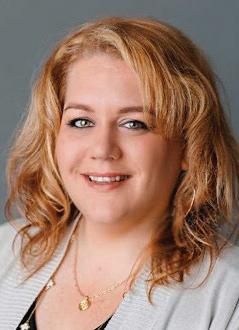
Colleen Keyworth, vice president of sales and marketing at Online-Access. Colleen Keyworth

What Keyworth loves most, though, is watching contractors succeed and their businesses grow. “It’s incredibly rewarding. I also value the sense of community and the chance to give back, whether Continued on page 32
Eddie McFarlane,
Eddie McFarlane
35272689 © Alexander Raths | Dreamstime.com









PERFORMANCE MEETS PARTNERSHIP.







HEAT TRANSFER FLUIDS FOR ANY APPLICATION

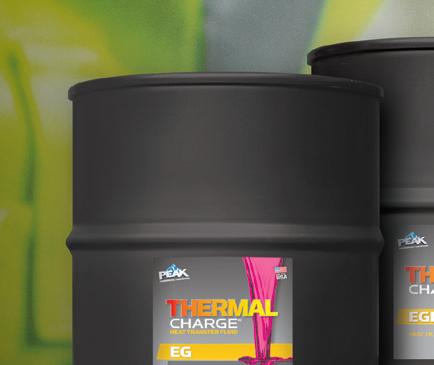

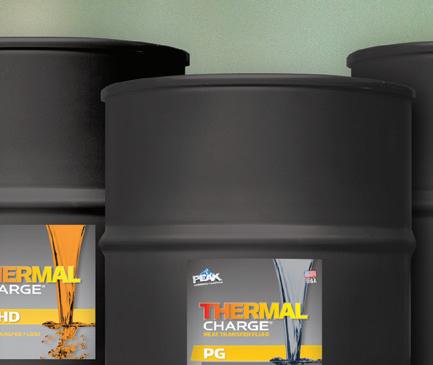




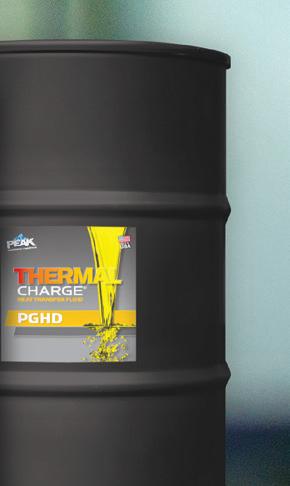


PROVIDING GLYCOL-BASED HEAT TRANSFER FLUID TO KEEP YOUR HVAC SYSTEMS AND PROJECTS RUNNING SMOOTHLY.
Thermal Charge® offers application-specific heat transfer
fluids, innovative inhibitor technology, and industry-leading service and fulfillment so you can power through every challenge, need, and demand.

Visit thermalcharge.com to find the right heat transfer fluid for your application.
Smarter, Faster, Stronger How Artificial Intelligence is Changing the Game for HVAC
Contractors
Artificial intelligence is no longer a futuristic concept— it’s quickly becoming a practical tool in the HVACR industry. From streamlining dispatch operations to improving call center accuracy and bookings to coaching techs on virtual ride alongs, contractors are discovering how AI can save time, cut costs, and deliver better service to customers.
For HVACR contractors, the value of AI isn’t about replacing people—it’s about empowering them. Smart dispatching platforms are helping companies optimize routes and reduce wasted time, while also improving pricing strategies, forecasting demand, and even enhancing customer communication. The result is a stronger, more agile operation that allows contractors to focus on what they do best: delivering comfort and reliability.
According to a report from Housecall Pro earlier this year surveying over 400 home service contractors across the country, over 70% have tried AI tools in some capacity, and about 40% are now using AI actively in their businesses. According to the report, 54% of business owners under 35 are already using AI to automate parts of their operations, roughly twice the rate of those over 65. Notably, AI adoption is consistent across business sizes—small shops are embracing AI nearly as much as large ones.
“Contractors said AI helped them save about 4.2 hours a week, on average, across everything we did,” says Roland Ligtenberg, Housecall Pro co-founder and senior vice president of innovation and growth. “Over half of them credited AI with some of their business growth.”
Ligtenberg stresses that AI is not a replacement for the skilled trades. “I love to describe it as our HVAC pros have standing jobs. AI is really great at sitting jobs. It’s super beneficial in that it frees up time for our pros to focus on those things that are truly difficult.”
Patrick Johnson, head of contractor experience at Rilla, points to the increased private equity investment in the industry making the skilled trades more mainstream. And, because of this, many new products are being tailor-made for trade pros.
“At this point, AI has fully penetrated,” he notes. “Contractors understand that it’s something that can give them a competitive edge. If you have a tool you can optimize, let’s say dispatch like ProBook does, or coach your team a hundred times faster, like Rilla—there’s a sense that if you’re not using it, you’re letting an opportunity pass. Especially in such a competitive space like HVAC, if you’re not using it, your competition probably is.”

Housecall Pro’s survey of over 400 home service contractors across the U.S. finds that over 70% have tried AI tools in some capacity, and about 40% are now using AI actively in their businesses.
Vincent Payen, senior vice president and general manager of Pro Products at ServiceTitan, agrees that it’s a fascinating time to be in the trades.
“It reminds me a little bit of Ford assembly lines as a moment that fundamentally transformed the industry because we are seeing HVAC businesses transform how they operate nearly in real time,” Payen explains. “Every week, we see businesses automate something new, putting together AI solutions to achieve, in some cases, end-to-end automation. On ServiceTitan, we see some contractors who are automating full jobs end-to-end, from the marketing campaign creation, the customer support piece—like booking, dispatching, etc.—where effectively, besides in the field, no human intervenes in the process. Even just a year ago, that was not really thinkable, or at least not with the level of quality that we’re seeing happen today.”
The pace of innovation is incredible, Payen adds, especially with how contractors have been able to leverage the technology for their businesses. “Historically, the trades have been late in adopting technology, and we’re absolutely seeing the trades being at the forefront of what AI can do because the applications are so practical and so powerful given the challenges that these businesses have to operate.”
Investment versus ROI
Rocky Ozaki, founder and CEO of The NoW of Work, has worked with many home services contractors on developing the right framework to adopt AI solutions into their businesses. There’s always a cost involved, but if contractors don’t consider the proper use cases or create buy-in with their team, the cost of failure could be infinitely more expensive.
“Some subscriptions could cost contractors tens of thousands a year,” Ozaki says. “That’s potentially out of the range for some businesses. This is why framework is important. If you start with a problem to solve, and that problem ends up costing $40,000 a year with an AI solution, if it’s your biggest problem that can turn your bottom line around by a quarter of a million dollars, is $40,000 really a lot of money? No, because the ROI is there.”
On the other hand, if a contractor adopts a blanket AI tool that everyone is using for $40,000, and only gets a $20,000 improvement, the company never should have been using it in the first place, he adds.
“One thing to note is we’re not always calculating ROI the same way as we traditionally do,” Ozaki says. “If you don’t join this AI train, you’re going to lose staff. If you’re trying to hire top talent, which I think most of us try to do, what happens when there’s a team member or a potential candidate who has the option to work at your company—that is not on the AI train—or another company that is experimenting with AI, learning it, and growing with it? Where do you think that talent is going to go? That’s part of the ROI piece, too. Can we afford to do it financially, and secondly, can you afford not to if we believe we’re in a talent crisis? Top talent wants to be upskilled on it, that’s return on investment, to me.”
According to Payen, some contractors love experimenting and trying new things, but not every business should start at the same place.
“The journey is very personal to these businesses,” he says. “If used well, in every part of the funnel, every part of the business has a story of AI being able to unlock ROI. But how do you do it? How do you do it while preserving who you are as a company? The No. 1 thing is for AI to be efficient and powerful. It needs data and context because the capabilities an AI solution may have can be very different in real life when applied to a business. If this AI doesn’t have the right integration and context, it will not be able to make the right decisions.”
While the number of different AI solutions in the marketplace is multiplying, which is exciting, Payen notes, it can also lead to danger and confusion. “You can end up with a mismatch of five AI solutions in different points in the business that don’t talk to each other, don’t have context about what each one is doing, and you actually end up with an outcome that could be worse than what you’re doing today.”
Humanizing Technology
Payen stresses that being thoughtful about AI adoption and translating the essence of who the company is in a highly automated AI-powered operating model is really important.
“Otherwise, it’s not going to feel good and pleasant,” he says. A good example of this is the virtual agents and chatbots who answer the phone and book jobs—some companies are giving them a name.
“It’s interesting that it’s the first thing they do,” Payen says. “They’re investing in a machine automation product, and the first thing they do is give it a name so it’s more like a human. They actually talk about it like it’s a human. ‘Oh, Max handles that.’ And it’s amazing because the AI becomes part of the team, it’s not just a computer doing something.”

Additionally, the report notes that 57% of AI-using contractors say it’s helped their business grow. It does so mainly by capturing more leads and jobs (through faster response times and never missing a call) and boosting marketing reach with AIgenerated ads and content.
Rancho Cordova, California-based Bonney Plumbing, Electrical, Heating & Air has dubbed its virtual AI agent as “Sarah.”
“We have an initiative across the company to really lean into AI where we can and where it makes sense,” says Angela Kump, junior system administrator at Bonney. “We are using ServiceTitan Contact Center Pro Voice agents, but also things like Gemini from Google, and Google’s Notebook LM to create internal chatbots for ourselves. We’ve uploaded and connected our own knowledge base sources so our employees can interact and ask questions of these different notebooks like they would any other person and get a response. We kicked off the initiative last year, and when we found out these virtual agents were going to be part of it, we got super excited. The virtual agents have allowed us to flex our call center more than we were able to do before.”
Previously, Bonney used an answering service to handle overflow and after-hours calls, but those agents didn’t necessarily handle the calls the way Bonney would have liked.
“Answering services don’t have the same investment in your business as your actual CSRs do,” Kump says. “Using Contact Center Pro, we’ve really seen those virtual agents handle the call the same way every time. They’re not going to have a bad day where they don’t handle the customer in the way you would expect. The AI virtual agent came with a basic name, I think it was Sam. From day one during onboarding, we wanted to give it a different name. Sam didn’t sound like what we wanted her to sound like, but Sarah was a great human-sounding name that wouldn’t be off-putting for our customers. Internally, it’s so much easier for it to have a human name—she’s just another person on the team.”
Housecall
Pro
Over 80% of contractors using AI say the tools met or exceeded their expectations. On average, AI adopters reclaimed over four hours per week from admin tasks like writing emails, data entry and follow-ups, according to Housecall Pro.
Bonney has three sister companies, and each has its own virtual agent.
“Instead of reusing Sarah across the board for all four companies, we gave them each their own name,” Kump explains. “Sarah came first, then we added Alana, Nora, and Ivy. They are all female voices, so we went with female names—something that wouldn’t be too out of the norm. We came up with Sarah on the spot ourselves, but for the others, we actually turned to ChatGPT and gave it specifications for the location of the company and the general feeling we wanted the name to have. So yes, we used AI to name our AI.”
Sila Services, a home services platform featuring over 40 brands and more than 2,500 employees, has been leaning into AI in a very intentional way, according to Eddie McFarlane, vice president of training, development, and engagement.
“At Sila, we don’t look at AI as a replacement for people—we see it as an accelerator,” he says. “We have a pilot program where after training we use an virtual buddy AI that helps us review technician ride-alongs and call recordings to give faster, more actionable feedback. Instead of waiting weeks for a manager to catch an issue, AI can flag patterns in real time. We’re also pretty far into rolling out AI to support call center agents. We have used AI for after-hours and overflow. And I use it for internal productivity—I’ve built a personal AI assistant, tongue-in-cheek named “Eddie’s Little Helper.” It organizes emails, pulls out tasks, and keeps me on top of priorities. A few of our managers are experimenting with similar tools.”
While Sila hasn’t gone as far as to name its enterprise pilots yet, McFarlane notes he recognizes that humanizing AI makes it less intimidating for teams, and it’s something Sila eventually plans to do. “For now, we’re more focused on testing and using AI in ways that support technicians, salespeople, and managers without disrupting trust.”
Scott Sharrock, COO of Jolly Plumbing, Drains, Heating & Air, also notes that while the company is using AI across several business areas to improve efficiency, customer experience, and training, it also has not given the technology a name.
“We use Avoca to answer all calls outside our normal business hours, including weekends and holidays,” he says. “It integrates directly with ServiceTitan, automatically booking jobs to our dispatch board with complete customer and job details. The name that Avoca uses is Sara. For now, we see AI as a set of tools that make our team more effective and allow us to focus on what matters most: serving customers. One of our core values is ‘Here to Serve.’”
Jolly also uses Probook for dispatching, Chiirp for customer communication, and ChatGPT for internal training.
“Probook uses performance data on each technician and job type to ensure the right tech is sent to the right job,” Sharrock says. “It factors in a metric we call “dollars per door knock” and even optimizes dispatching when similar job types are nearby. While efficiency matters, our main priority is always matching the best technician to the right customer need. Chiirp helps us maximize our customer database. We use it for outbound campaigns such as scheduling system checks for current members, offering promotions to non-members, and running personalized text, phone,

According to Houscall Pro’s report, 54% of business owners under 35 are already using AI to automate parts of their operations, roughly twice the rate of those over 65. Notably, AI adoption is consistent across business sizes. From solo owner-operators to 50+-person companies, small shops are embracing AI nearly as much as large ones.
and chat campaigns. And, internally, we use ChatGPT to support leadership and training development. All of our trainings follow a set formula (opener, content, skill practice/group discussion, action items). AI helps us refine outlines, strengthen content, and break through obstacles like specific objections or skill gaps.”
Adoption Challenges
Johnson used to work as a customer success manager for Rilla, and in that role, helped onboard hundreds of HVACR and plumbing contractors onto the platform.
“The difference between good and great results is going to be how they view the AI working for them,” he says. “Some contractors live with the assumption that the AI is just going to do everything for them. All of these tools are here to augment, improve, and make you more productive. We cannot replace you.”
According to Ligtenberg, the biggest hurdle for contractors is connecting all the tools and data sources because they all live in different places.
“AI is only has good as the data it has,” he explains. “A lot of people have various service-level conversations with AI without giving it all of the context it needs to produce a very good output. The wrong way to adopt a new AI solution is to think that it’s a magic bullet for all your problems. Remember, garbage in, garbage out. I like to describe AI as a really smart 12th grader right now. It’s getting smarter, but it’s still in high school—it makes stupid decisions, it doesn’t want to do things right. You still have to have a human in the loop to verify and give it feedback. You’ve got to give it the right data sources. A lot of the stuff we do at Housecall Pro is just around how do we make sure that our AI team members have as many data sources as they can so they can be as smart as they can.”
Ozaki’s tagline is “AI adoption is broken.”
“I always talk about shiny object syndrome—just doing what everyone else does,” he says. “The mistake there is that AI has to be anchored to what problem you are trying to solve. Every contractor is different. Another one is they don’t consider the cultural factor of AI adoption. More studies show that it’s not the technology that’s hard to implement in the organization, it’s the change management. That’s why, in our program, we always start with a survey of how the staff feels about AI. Do they think it’s Terminator level? Are they excited about it? In a legacy industry like home services, if 80% of your team is uncertain about this technology or don’t even know what it is, and is afraid of it, one of the biggest mistakes the contractor can make is forcing it on them versus saying here’s a tool we’re going to experiment with, and getting people to opt in. These are humans that we’re talking
about, and you’ve got to really be empathetic to their journey.”
Embrace the New Normal
Looking into the future, as AI becomes commonplace, it will fall into the same category of just another tool, much like an anemometer or vacuum pump, Johnson says. “It might be the most important tool, because it touches all parts of the business. I would recommend to all managers, technicians, sales reps, etc., become AI literate. Because managers are going to have to learn how to prompt engineer. They’re going to have to learn how to program AI agents to assist with tasks and workflows because there is such a potential time and money savings benefit.”
AI is going to change every aspect of operations for home service companies, Ozaki says. “What history tells us is that emerging technologies generally scale together. There was a time when cell phones came out, and with it, true 3G-type high internet speed and social media. These are three profound technologies. Social media alone wasn’t going to change the world if you didn’t have a phone, because most young people aren’t sitting on a desktop every day. And if you had a phone and maybe social media, but everything was dial-up internet, would it have been as powerful? No. When you put those together, it changed. In two to three years, we’re going to start to see more spatial computing, robotics, and, of course, AI. We’re going to see even faster quantum computing to some degree. They’re all going to rise together.”
CLEAN. SIMPLE. CONNECTED.
SENSI EQUIPMENT INTERFACE MODULE
(Indoor + Outdoor)
Simplify HVAC installations by reducing the need to pull additional wires during a system upgrade.
-Sensi Touch 2 compatible -3 accessory terminals for IAQ
-Waterproof for indoor/outdoor use
-No separate gateway for Wi-Fi
According to Payne, the businesses that embrace AI will be absolutely transformed—able to be more efficient, more profitable, and grow faster.
“Be open to rethinking how your business functions, but stay true to who you are and what has made you successful,” he says. “How businesses take care of their customers, how it connects with them, is very important to preserve. The biggest risk everyone has with AI is that everyone sounds the same because everyone has the same AI enterprise service. Choosing an AI solution that will be customizable will be important. It also means using AI in a way that’s personal and that’s thoughtful.”
AI is going to run the office of an HVAC business, Ligtenberg says. “It’s going to be doing the marketing, adjusting ad spend by channel, season, and campaign type. All of the virtual customer interactions and answering the phones will be AI first. I think a lot of companies will have a hybrid approach, where if someone still wants to talk to a human, it will roll over to a human. And that’s the right way that human and AI interaction should happen. It shouldn’t be all AI or no AI.”
Ligtenberg adds that contractors should start now—don’t wait for it to be perfect.
“Let’s start building momentum both internally with your team members and just with yourself. Data shows that 82% of contractors who tried AI said it met or exceeded their expectations. Treat AI like an apprentice. It will learn as you use it.”

How an HVAC Contractor Used Mobile Tech to Serve Customers During Historic Texas Floods
In July, Central Texas faced catastrophic flooding, claiming lives and causing billions in damages. To the T Plumbing, Heating & Air leveraged Housecall Pro’s mobile app to maintain operations despite power outages and flood barriers, ensuring community support and business continuity.
This past July, Central Texas experienced one of the deadliest floods in U.S. history. On July 4, slow-moving downpours fell on hard, drought-affected ground, creating rapid runoff and catastrophic flash flooding, forcing many communities to declare flash flood emergencies. The Guadalupe

River rose 26 feet within 45 minutes, according to state officials. The natural disaster claimed at least 135 lives, many of them children, and caused an estimated $18-22 billion in total damage and economic loss, according to Accuweather.
One local HVAC and plumbing contractor kept its doors open despite having no power and only limited, spotty cell service. To the T Plumbing, Heating & Air’s resilience highlighted the essential role contractors play in keeping communities safe and

Images courtesy of To the T Plumbing, Heating & Air of Austin
By using the mobile app, To the T identified some people in the community who needed portable air conditioning units after power was eventually restored. Lane Williams, along with his wife, personally used a bicycle trailer to walk the unit across a bridge that was closed to vehicle traffic due to flood damage. The photo depicts how the bridge had shifted due to flood waters.
A propane tank ended up in a tree after extensive flooding in Central Texas.
comfortable, even in crisis. The key to keeping operations running was using Housecall Pro’s mobile app. The software is cloud-based, so To the T was able to keep in contact with its employees and customers.
“We were completely landlocked by low water crossings, but our technicians were not,” says Lane Williams, owner of To the T Plumbing, Heating & Air of Austin. “We were able to log into the mobile app. We answered calls and scheduled services — like any other day — directly through the mobile app because we were without power for three to four days. The functionality of the app was a lifesaver. We didn’t miss a beat.”
The company has two locations, one in Leander and the other in Round Rock, Texas. Knowing that the contracting company was still up and running was a huge morale boost for both team members and customers alike.
“We had customers who knew where our Leander office was reaching out to us, checking to make sure we were okay,” Willaims says. “When they found out we
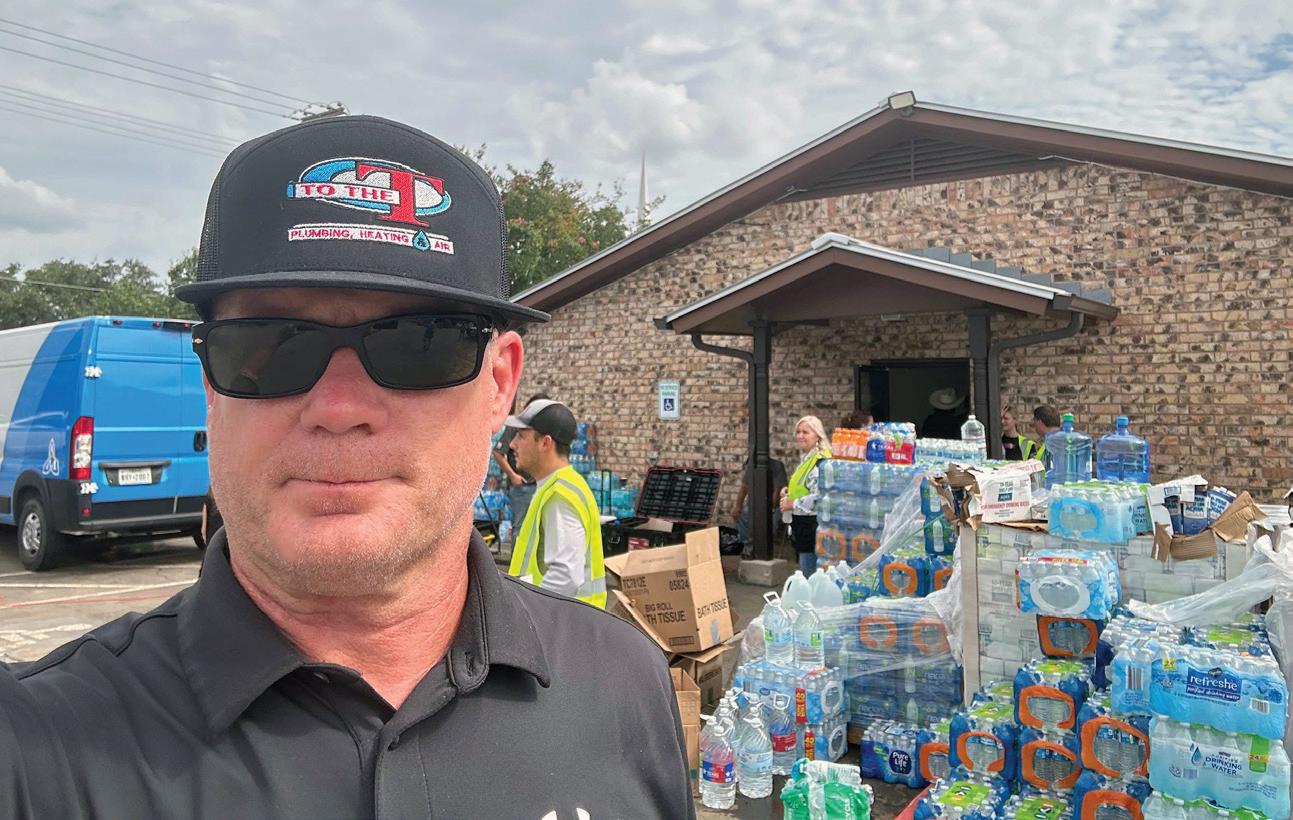
Lane Williams, owner of To the T Plumbing Heating and Air of Austin, volunteered in the community after the July 4 flash floods, and was still taking calls and scheduling service through Housecall Pro’s mobile app.
were still working, they were impressed. Our technicians rely on their jobs to take care of their families. Knowing we were still able to schedule jobs from an island, basically, gave them peace of mind.”
Williams notes that through the mobile app, To the T identified some people in the community who needed portable air conditioning units after power was eventually restored. Williams, along with his wife,
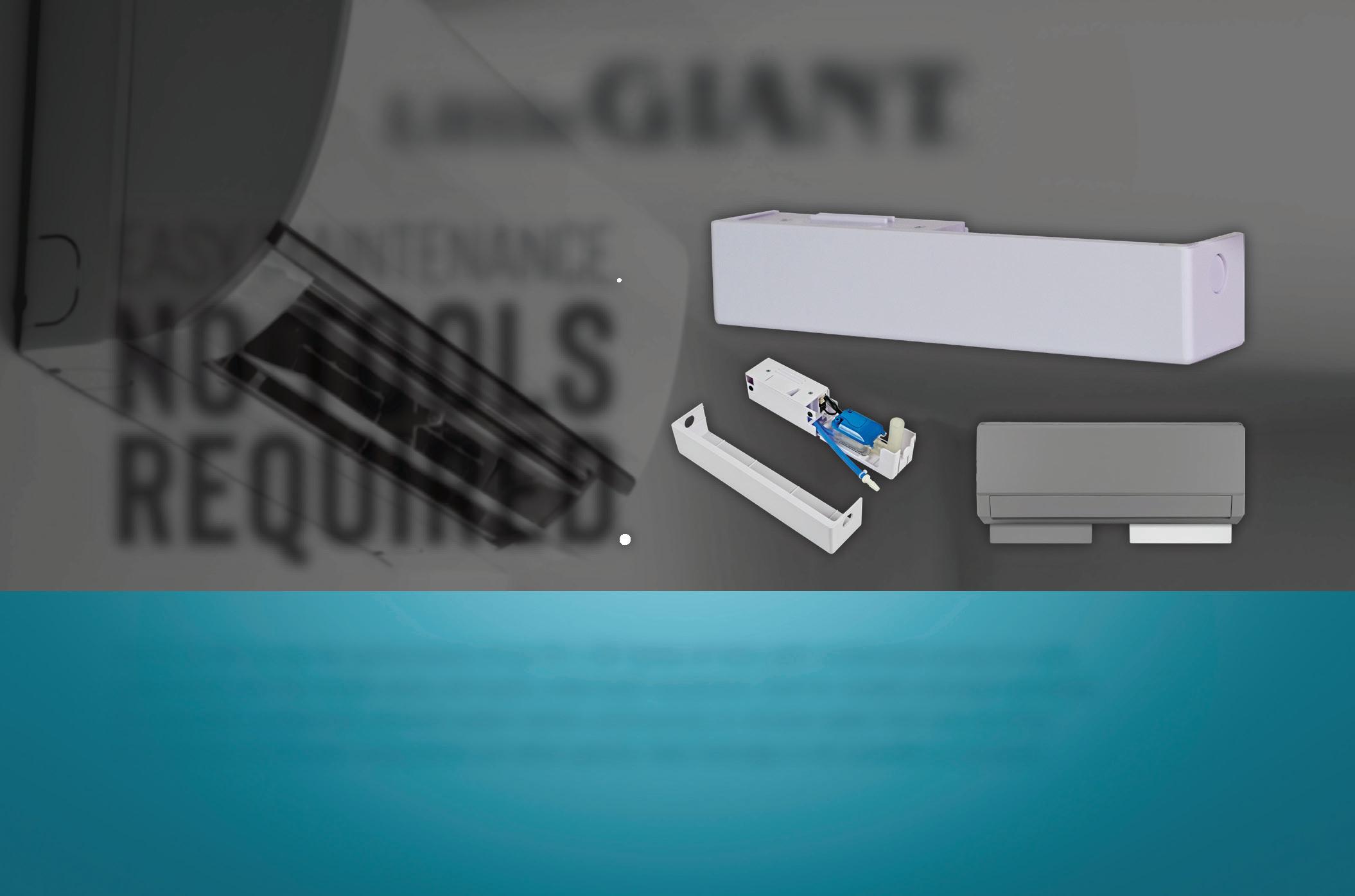
Easy Maintenance. Required. No Tools
The EC-1U-DV brings the performance of our EC-1-DV Series of mini-split condensate pump to a slim undermount unit that installs easily and neatly underneath equipment. Built for reliable and quiet operation, the automatic condensate removal system works continuously to remove water from any ductless mini-split air conditioner evaporative coil when gravity-feed drainage is not possible or practical.
personally used a bicycle trailer to walk the unit across a bridge that was closed to vehicle traffic due to flood damage.
Technology to the Rescue
Thanks to Housecall Pro’s mobile app, To the T coordinated 17 calls that fateful week following the flooding.
“My wife and I were volunteering in
the community and still taking calls and scheduling jobs,” Williams says. “Specifically, Mark McMillion reached out to us about his house right after floods; his property was partially flooded. He saw our Facebook videos and reached out. We were able to get him on the schedule and are still working with him now on multiple plumbing projects.”
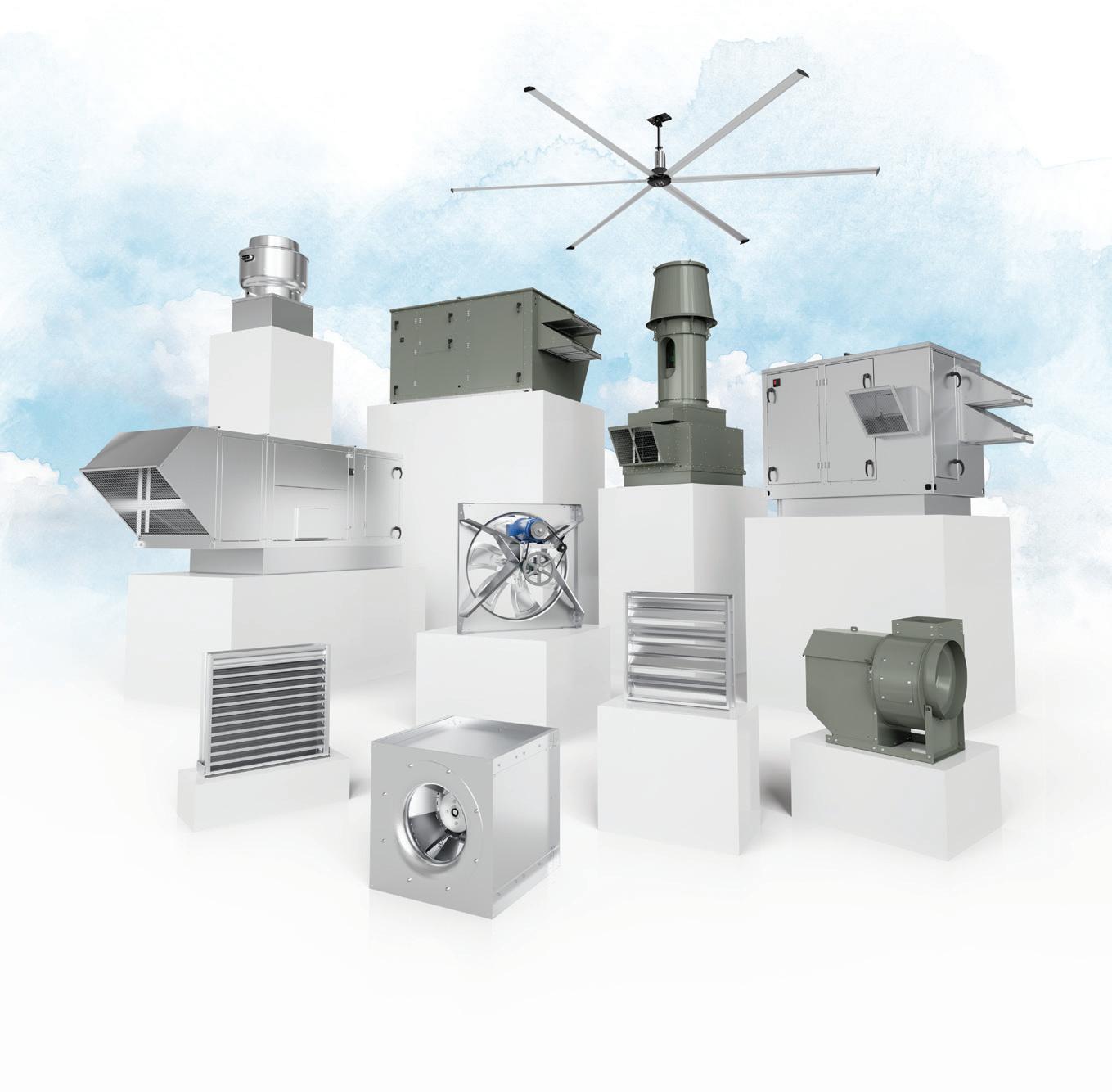
Innovative Products. Proven Performance.
If you only think of Greenheck as a fan company, think again. We engineer and manufacture the industry’s most comprehensive line of air movement, control, and conditioning products for commercial, industrial, and institutional buildings. Our energy-efficient products keep occupants comfortable, productive, and safe while supporting sustainability. Let us help with your next project.

Williams notes that without the mobile ability of the app, the business would have ground to a stop.
“My guys would have had the ability to wor,k but wouldn’t have known where to go or when to go there,” he says. “We had the ability to gather all the customer informa tion and put it in the app. We were able to schedule the jobs and convey all customer information to our techs directly through the app. We didn’t miss a day of work.”
While recovery would have progressed eventually without the use of technology, Williams adds that it wouldn’t have been as smooth.
“We also wouldn’t have had the ability to continue to service our community in the midst of the chaos. Housecall Pro kept the chaos in our community from becoming chaos in our business,” he says.
Overall, Williams advises HVAC con tracting business owners to prepare for any scenario. “Be prepared — partner with companies like Housecall Pro. You never know when something like this can hap pen. With a strong partner, you can keep the doors open and weather any storm!
“In times like these, people’s true nature comes out,” Williams adds. “The true na ture of our community is one of love and resilience. Our neighbors came together for one another; our city, county, and state came together to help all the families nega tively affected. The rebuilding is ongoing, and with the help of Housecall Pro, To the T Plumbing, Heating and Air will continue to support our neighbors and ensure that they get their lives back on track.”


Flood waters washed away an entire dwelling, leaving behind the slab, following extensive rains in Central Texas.

C E L E B R A T I N G
H V A C R E X C E L L E N C E .

N o m i n a t e y o u r c o m p a n y




o r a d e s e r v i n g i n d i v i d u a l



f o r a 2 0 2 6 A C C A A w a r d b y

N o v e m b e r 3 0 .






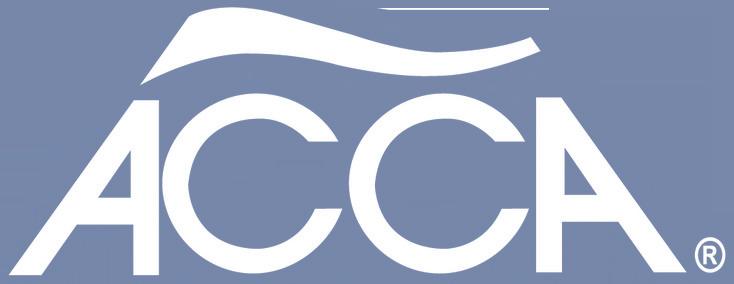

a c c a . o r g / a w a r d s

Employee retention issues? Keep your team inspired and motivated with a uniform program
Your company is only as good as the people that make it, and in today’s competitive job market, it’s becoming tougher and tougher for businesses in the trades to keep skilled workers on staff.
There’s currently a dire need for more skilled tradesmen in the U.S. labor force, as older employees retire and younger generations overwhelmingly choose four-year colleges over trades schools. But even with a shortage in skilled labor, demand for work remains high — fueled by a healthy economy and a need to repurpose commercial real estate following the pandemic.
With such a competitive labor market, you must do everything you can to attract talent and separate yourself from your competitors to retain that talent. One way to separate yourself from your competitors and boost employee morale is to implement a uniform service — and Cintas is here to help, with our Apparel+ uniform rental service.
Learn more about how a managed uniform program can boost your retention efforts at cintas.com/contractingbus
INDUSTRY-LEADING WORK CLOTHES
With an extensive catalog, we can outfit your entire team — regardless of role. From breathable work shirts and work pants to keep your team comfortable to outerwear that will help them brave the elements, we’ll help your team dress for the job without the guesswork. Whether it’s top-of-the-line Carhartt® workwear or the flexible durability of Cintas Comfort Flex Pro®, an Apparel+ program features the work clothes that will inspire your team and keep them performing at their peak.
Plus, with several custom logo or embroidery options, you can bring your brand to life by establishing a consistent and clean-cut look among your employees, which will earn additional trust with your customers.
FRESH UNIFORMS FOR EVERY SHIFT
Rough days on the job can leave you with extra cleanup. Your team doesn’t need to bring their work home with them. With Apparel+ laundry and delivery service, we pick up your team’s dirty uniforms each week and deliver a fresh set of replacements for the week ahead. Your employees will appreciate starting each day feeling refreshed and confident while looking their best in wellfitting and well-cared for work clothing — all without the added chore of extra laundry.
NO UPFRONT COST
Purchasing high-quality uniforms for your entire team can cost thousands of dollars. Don’t risk your investment should you lose an employee or need any replacement work clothes.
Avoid the expense that comes with buying uniforms for your team in an unstable labor market. An Apparel+ uniform rental program requires no upfront cost, leaving you extra capital to better navigate the day-to-day challenges facing your business. Those savings could be used to invest in better equipment, upgraded facilities or additional employee benefits — which go a long way toward staff retention.
Ensure you’re ready™ and a step ahead of today’s challenging labor market. Give your employees top-tier workwear from premium brands, a sense of pride with well-maintained apparel and the flexibility that comes with keeping your capital in your operations. Get Apparel+ and get more than just a uniform program.






BOOST RECRUITMENT AND RETENTION WITH CARHARTT®

Give your business an edge in attracting and keeping top talent. Make your team feels valued with quality Carhartt® gear, backed by the world-class service and convenience of an Apparel+ workwear program.
Weekly laundry, repairs and delivery included
No upfront cost required




cintas.com/contractingbus









One Big Beautiful Bill’s Impact on HVAC: Tax Credit Cuts, Contractor Wins, and
the Path Forward
The One Big Beautiful Bill (OBBB) was signed into law by the president on July 4, 2025. The 870-page behemoth covers a wide range of topics. The HVAC industry felt multiple impacts from the bill, some positive and some negative.
What’s Changing?
The OBBB is eliminating several tax credits that impact HVAC decisions. Here’s a brief rundown.
• Section 25C (Energy Efficient Home Improvement Credit): This tax credit was for homeowners who install qualifying energy-efficient upgrades such as heat pumps, energy-efficient windows, doors, insulation, and electrical upgrades. The credit was for up to $3,200. The credit will end on Dec. 31, 2025.
• Section 25D (Residential Clean Energy Credit): This tax credit, which covers residential clean energy (geothermal and solar), will end on Dec. 31, 2025. The credit covered up to 30% of installation costs.
• Section 179D (Energy Efficient Commercial Buildings Deduction): This provision for energy-efficient commercial buildings enabled owners to claim a tax reduction per square foot for improving the energy efficiency of new and existing buildings. The credit will end on June 30, 2026.
• Section 45L (New Energy Efficient Home Credit): The credit, which incentivizes builders to construct energy-efficient new houses and apartments, has been a significant driver of the Energy Star Certified Homes Program for new home construction. The credit will end on June 30, 2026.
Why were these tax credits removed despite the urgings of many in the HVAC community?
“If you read the messaging that came out following the House Ways and Means Committee’s advancement of their version of the bill, the Republican caucus has a real issue with consumerfacing credits,” said Ryan Dougherty, executive director of the GeoExchange, a nonprofit national trade association representing companies and individuals in the geothermal heating and cooling industry.
Wins and Losses
Removing some of the energy efficiency upgrade tax credits for heat pumps, geothermal, and solar upgrades will undoubtedly impact the market.
The nonprofit research organization, American Council for an Energy-Efficient Economy (ACEEE), which develops policies to reduce energy waste and combat climate change, denounced the OBBB. In a press release, the organization’s executive director,
Steven Nadel, said, “The bill will raise energy costs and make it harder to keep the lights on.”
Nadel added, “Taking away incentives for energy-saving improvements would raise monthly bills for families and businesses. It will only exacerbate the growing strain on the electric grid.”
Despite the removal of multiple rebates and tax incentives, the OBBB does offer some wins for the HVAC contracting industry.
“We see in the One Big Beautiful Bill some fantastic wins for contractors, and on balance, it has more benefits for contractors and the contracting business,” said Sean Robertson, vice president of membership, advocacy, and events for the Air Conditioning Contractors of America (ACCA).
Robertson counts Section 179, which allows for immediate expensing of commercial HVAC equipment, as a win for HVAC contractors. “The OBBB increased the cap on Section 179 and combined it with bonus depreciation, which makes it a powerful incentive, allowing commercial customers to expense in one year equipment that previously had to be depreciated over half of 39 years.”
“The silver lining of the year-end deadline is that it could lend urgency to customers making a buying decision, particularly coming into the winter. Smart contractors should be out there now preparing to make the most of this tax incentive before Dec. 31.”
— Sean Robertson
Other wins include making 199A (small business tax deduction) permanent. The provision matches the corporate tax cuts that the Federal Government made permanent in the 2017 tax bill and allows small businesses that are pass-through entities to enjoy those same benefits. “In many cases, it levels the playing field between small business and big business,” Roberston said.
Another win is the expansion of 529 accounts and Pell Grants to cover more trade-related education, including in-house
training programs and high-quality shortterm trade education programs.
Impact on HVAC Contractors
Removing tax credits and provisions is sure to shake up the marketplace.
“Clearly, there’s some anxiety in the marketplace because tax credits are an addictive substance,” Dougherty said. “When
you inject them into the market and people start to rely on them, yanking them away is going to be challenging. We’re basically telling everyone to adapt to an entirely new environment overnight.”
The elimination of 25C (the ability to offer up to $3,200 to homeowners towards installation of heat pumps, etc.) will negatively impact customers’ purchasing

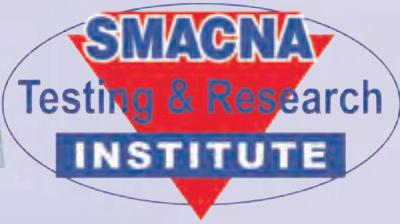

















decisions. In the short run, the impact could be positive.
“I think the silver lining of the year-end deadline is that it can lend urgency to customers making a buying decision, particularly coming into the winter,” Robertson said. “Smart contractors should be out there now preparing to make the most of this tax incentive before Dec. 31.”
When the incentive is fully phased out, contractors will probably see more customers shift towards minimum efficiency systems and smaller jobs. What can HVAC contractors do to try to maintain sales of geothermal systems?
“A good initial step for a contractor to talk to a homeowner effectively about this type of technology is getting training from the International Ground Source Heat Pump Association,” said Eric Torykian, executive director of Mission GEO, which promotes awareness and benefits of geothermal heat pump systems.
The key Torykian says is replacing myth with math. “When people aren’t used to something, they initially object to it. For example, the homeowner may want geothermal heating and cooling in their home, but the contractor says, ‘I have a similar product at two-thirds the cost.’”
“The residential contractor needs to be educated about the benefits of a system that lasts twice as long as a traditional unit, has four times the efficiency, and doesn’t use any gas,” Torykian said.
Another point Torykian suggests contractors use to sell customers on geothermal heat pumps is to ensure they understand it may increase the asset value of their home. “Even if they’re going to move in five years, the next buyers will inherit reduced operations and maintenance costs and a longer system life.”
9/10/25 12:00 PM
The long-term benefits of geothermal heat pumps are clear. However, upfront costs are steep.
“The biggest impediment to adoption of geothermal is the high upfront cost compared to conventional HVAC equipment,” Dougherty said. The challenge of adopting geothermal is heightened because HVAC replacements often happen in emergencies, leaving little opportunity for thoughtful planning or investment.
Unlike the solar industry, which overcame similar barriers through third-party ownership models like leases and power purchase agreements, geothermal lacks widespread financing innovation. “The OBBB added to the revenue code the ability for geothermal systems to be leased for the first time,” Doughtery said, “which will allow industry stakeholders to pursue these sorts of business models.”
Ultimately, sales come down to relationships.
“It’s cultivating that customer relationship and emphasizing the quality job that your company delivers versus simply selling a more efficient piece of equipment,” Robertson says.
The OBBB brings significant changes for the HVAC industry by eliminating key consumer tax credits while offering new incentives for contractors and manufacturers. As the landscape shifts, HVAC professionals can adapt to continue selling energy-efficient solutions. Success in this new environment will depend on how well contractors communicate value, build trust, and pivot from selling incentives to selling real, lasting performance.
Larry Bernstein is a freelance writer based in northern New Jersey. He specializes in construction technology; education technology; and transportation, logistics, and supply chain.
Viega Celebrates Grand Opening of Sustainable Ohio Manufacturing & Training Facility

MANTUA, Ohio—On Sept. 4, Viega North America officially opened its new state-ofthe-art manufacturing and training facility in Mantua, Ohio. The project marks a significant milestone in the company’s North American expansion strategy.
“By increasing our manufacturing presence here, we aim to deliver products faster, give back to the local economy, and ultimately continue innovating to meet the evolving needs of the industry,” said Markus Brettschneider, CEO of the Viega Group. “This facility serves as a testament of our unwavering commitment to our customers, today and for decades to come.”
The 244,000 square-foot facility, located 40 miles Southwest of Cleveland, is fully electrified and operationally carbonneutral since day one—something less than 30 facilities in North America can actually say—according to Viega North America CEO Marki Huston .
The facility features an energy-efficient design with extensive natural lighting and water conservation measures, automatically timed lighting to turn off when a room is unoccupied, and AAON air-source
heat pumps. Viega North America is on track to earn LEED gold certification for the facility by October.
“This facility stands a model of our advanced production and commitment to sustainability,” Huston said. “But our most important investment is in the trades we serve. This facility provides hands-on training, education, and ultimately a connection to not only the quality people who use our products, but also the quality people who build our products. And it enables our customers to have the skills and supply they need long term to be successful as market demands grow.”
The facility represents a $178 million investment into the local economy, and expects to employ 68 people within the first two years of operation.
“Beyond these walls, this investment serves the more than 1,500 customers across North America that rely on Viega every day and now rely on this community,” Huston said. “They trust us with their most important projects, and this facility is a way of us saying we are invested—we are invested in North America,
we are invested in this economy, and we are committed to delivering products and services, not just for today, but for generations to come.”
Viega broke ground in November 2023, and the facility became operational as of July. It represents Viega’s second North American manufacturing facility and third training center. The building features 11,000 square feet dedicated to education and skill development. The Interactive Learning Center features three classrooms with seating for up to 118 participants, which is more capacity than any other Viega seminar center. The Interactive Learning Center also has two fully equipped workshops showcasing real-world solutions across residential, commercial, industrial, and marine applications. The building also features a catwalk above the manufacturing area, offering a birds-eye view for visitors to see the entire production process in action.
Viega began ProPress production in the new facility in July. MegaPress production is expected to launch next year.
For more information, visit viega.us.
Viega North America CEO Marki Huston cuts the ribbon to officially open the new Mantua, Ohio, manufacturing and training facility.
Nicole Krawcke © EndeavorB2B
Lennox Rolls Out AI Agents to Enhance Technician Support and Customer Experience
DALLAS—Lennox, a residential HVAC manufacturer, is stepping up its digital transformation with the launch of new AI-powered support tools built to make life easier for contractors, technicians, and homeowners alike.
The centerpiece for contractors is the Lennox Technical Support AI agent, already in use by more than 7,000 technicians across North America. Designed specifically for the HVAC trade, the tool helps dealers and techs troubleshoot, service, and repair Lennox equipment faster and with greater accuracy.

Built on Lennox’s technical data and powered by a conversational interface, the AI agent gives field pros immediate access to critical information—warranty lookups, parts finder, error code explanations, and step-by-step troubleshooting guidance. It currently recognizes more than 250 error codes and provides solutions for common service issues. That means less time on the phone, fewer delays, and quicker service for customers.
The tool is available in English, Spanish, and French on LennoxPros.com and can even be accessed via SMS, making it

useful in areas with limited internet connectivity. Since its launch earlier this year, technicians have logged more than 15,000 sessions, with a 96% positive feedback rating. Weekly usage now tops 700 sessions, showing just how much the field is embracing it.
“This investment is about giving contractors the support they need right when they need it,” said Prakash Bedapudi, Lennox chief technology officer. “By putting information at technicians’ fingertips, we’re helping them save time in the field, reduce callbacks, and deliver a better experience for their customers.”
Alongside the technician-facing tool, Lennox also introduced a homeowner-focused AI agent on Lennox.com. Available in multiple languages, it helps customers quickly find local Lennox dealers, register products, access warranty details, and troubleshoot smart thermostats—making routine support requests easier to handle and freeing contractors to focus on service work.
By investing in AI-driven support solutions, Lennox is giving HVACR contractors tools that reduce downtime, improve service speed, and strengthen the customer experience—while helping businesses operate more efficiently in today’s fast-moving market.
GF Building Flow Solutions Brings Water Efficiency to Contractors Nationwide

Inside the mobile showroom during GF Building Flow Solutions’ Leading with Water Tour.
Nicole Krawcke © EndeavorB2B
STERLING HEIGHTS, Michigan— GF Building Flow Solutions hit the road this summer with its Leading with Water Tour, bringing a new mobile experience center to contractors nationwide. The tour highlights the latest in potable water and hydronic solutions for commercial buildings, offering hands-on demonstrations and showcasing how Uponor’s complete product systems can improve efficiency, durability, and sustainability.
The Macomb Group in Sterling Heights, Michigan, hosted one of the pit stops on the tour for local plumbing and HVACR contractors.
Mitsubishi Electric Trane HVAC US Names Tim Vordenbaumen CFO
SUWANEE, Georgia— Mitsubishi Electric Trane HVAC US LLC (METUS), a supplier of all-electric, all-climate Ductless and Ducted Mini-split and Variable Refrigerant Flow (VRF) heat

pump and air-conditioning systems, named Tim Vordenbaumen, CPA, as the company’s new chief financial officer.
As CFO, Vordenbaumen will be responsible for financial guidance to the senior leadership team as well as planning, implementing, managing, and controlling financial-related activities for METUS.
With 20 years of experience at Trane Technologies, Vordenbaumen has held a series of influential leadership positions. As Controller within Residential HVAC, he chaired the Limited Warranty Council, developing key strategies. He also served as Finance Leader of Parts and the Dealer Distributor Channel, where he spearheaded a successful supply chain cash flow initiative. His most recent position was Finance Leader for Commercial HVAC Americas. Prior to joining Trane, Vordenbaumen spent nearly seven years at a U.S. multinational technology company.
Following a successful three-year tenure, former CFO Shane Lawrence has assumed the role of Vice President of Assurance and Advisory Services at Trane Technologies. He will lead the Corporate Assurance and Sarbanes-Oxley (SOX) teams.
New Carrier Initiative Aims to Train and Hire 1,000 HVACR Service Techs
CHARLOTTE, North Carolina— Carrier Commercial Service and Automated Logic Field, part of Carrier Global Corp., have launched the first cohorts of TechVantage Ignite, a program to develop the next generation of commercial HVAC technicians and controls engineers.
TechVantage Ignite combines classroom training and self-paced online learning with mentorship and on-the-job training. The program begins with a twoweek introduction at Carrier University’s Charlotte, North Carolina, and Kennesaw, Georgia, training centers. Participants in the inaugural classes represent field offices across the United States, including Arizona, California, Georgia, Kentucky,
New Jersey, Texas, Utah, Washington and West Virginia.
“Thirty-nine years ago, I was in your shoes,” Rich Simpson, associate director, Field Service, Carrier Commercial Service said at the start of the HVAC program. “I can tell you from experience that working at Carrier is great. From a culture aspect, safety, providing you with the skills and development you need—we are committed to doing our best and helping you grow and learn.”
TechVantage Ignite is designed to increase the speed of learning and proficiency of new technicians and field engineers. The training plan is divided into a yearlong program, with learning objectives supported by service and field managers.
“We are thrilled to have the next generation of our business receive this early-career boost through the TechVantage Ignite program,” said Andy Bierer, managing director, Automated Logic Field. “These

hands-on experiences, coupled with our ongoing partnerships with trade schools and other organizations, are building a bright future for our industry.”
TechVantage Ignite is part of Carrier’s larger TechVantage Initiative, launched in January. The initiative calls for hiring 1,000 service technicians in the U.S. and providing additional training to over 100,000 Carrier and partner HVAC technicians over five years. This effort is driven by surging demand for technical expertise in the commercial HVAC sector, fueled by rapid growth in data centers, industrial facilities and large-scale infrastructure projects.
“We’ve added more technicians this year than any of the past five years,” said Jay Hoarell, managing director of Carrier Commercial Service. “We are well on our way to hiring over 1,000 technicians in the next few years, thanks to the outstanding efforts of our teams all across North America.”

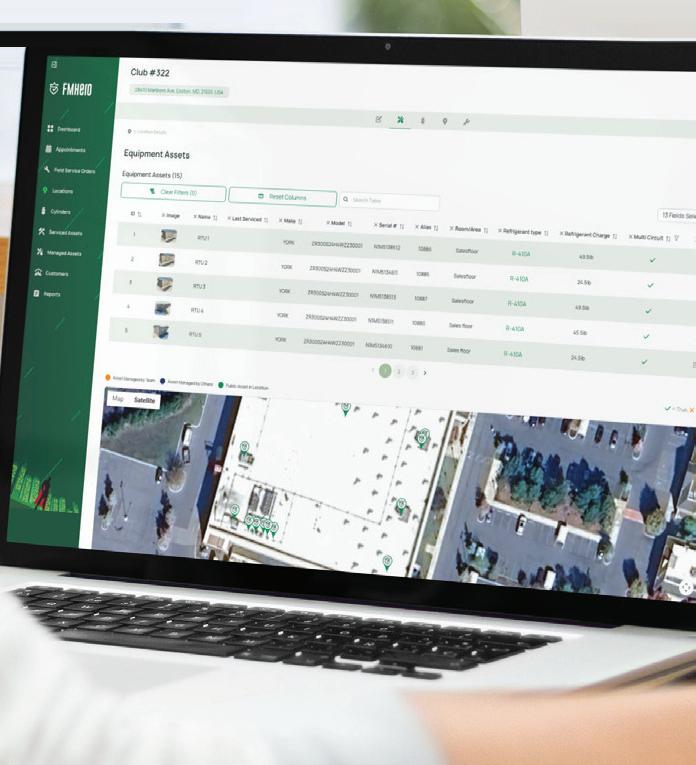
Vordenbaumen METUS
Revolutionizing HVAC: Digital Tools and AI Solutions Address
Technician Shortages
With the HVAC industry facing a technician shortage, the demand for smarter, faster, and more efficient solutions has never been greater. As a result, digital solutions are rapidly emerging to help fill the gap. From technician apps and remote access tools to generative AIpowered assistants, advanced digital technologies are transforming the way dealers and technicians approach installation, service, and repair. These solutions not only help address labor shortages but also help streamline workflows, reduce training time, and help enhance overall productivity, redefining the future of HVAC in real-time.
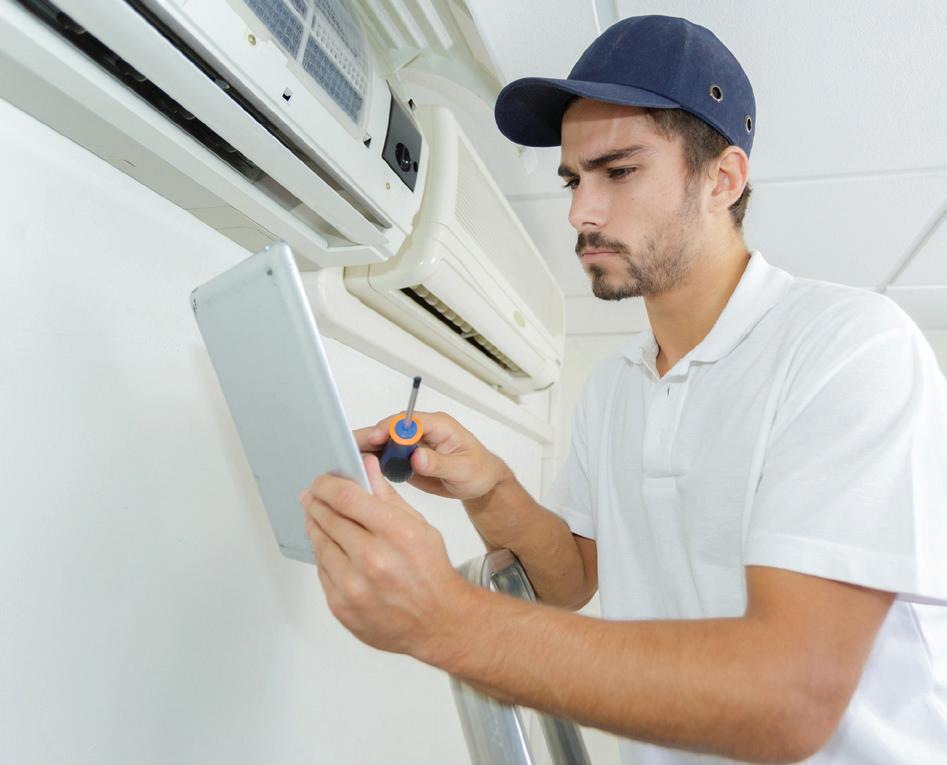
These AI and digital solutions are not replacing technicians—they are elevating them.
Digital Tools Designed for Technicians Help Enhance Workflow and Accuracy During Service Calls
Digital solutions are changing the way HVAC technicians manage service calls, improving speed and accuracy. Technician apps now include digital calculators, smart manuals, and other tools that help technicians navigate tasks in a fraction of the time. Traditional HVAC wiring diagrams span from 30 to 60 pages, offering detailed instructions on everything from wiring to airflow settings. Today, that vast amount of information is condensed into a user-friendly app, providing step-by-step guidance, visual aids, and real-time updates. For example, the app can quickly display the necessary wiring diagram, helping to eliminate the need for technicians to search through extensive manuals. This is especially valuable for newer technicians, as it helps reduce wiring errors, which account for nearly 80% of issues in wired systems, allowing them to troubleshoot, maintain, and resolve problems more efficiently.
Remote Access Builds Field Confidence for New Technicians
Remote access has become an essential tool in the HVAC industry, especially for supporting newer
technicians in the field. Like IT professionals troubleshooting computers remotely, HVAC technicians can now access homeowners’ thermostats from anywhere to help diagnose and resolve issues, playing a key role in preventative maintenance and system optimization. Technicians can proactively address potential issues by monitoring metrics such as temperature, humidity, pressure, and airflow, while receiving alerts for any irregularities that could lead to costly breakdowns. Remote access also helps extend system lifespans and enables technicians to handle multiple service calls from a central location. This improves efficiency and boosts the confidence of field technicians, especially those who are still gaining experience.
How Generative AI is Driving the Evolution of the HVAC Industry
Generative AI is reshaping the industry for emerging technicians by offering advanced tools that help improve field support and foster skill development. A new feature, powered by ChatGPT-like AI, allows technicians to ask questions to a virtual assistant for immediate on-site technical support. This assistant guides them through troubleshooting steps using a flowchart, like how a live expert would assist over the phone. With the advent of Generative AI in various service industries, it will now also be used to help provide live technical support in the field for HVAC installation and service needs. It is currently undergoing testing by professionals to ensure its reliability in various scenarios.
These AI and digital solutions are not replacing HVAC technicians—they are elevating them. By helping automate routine tasks, enhance diagnostics, and expand access to specialized knowledge, these technologies help HVAC companies work smarter, not harder. From technician apps and remote access to AI-powered assistants, these digital tools provide real-time support that helps entry-level techs grow and experienced pros solve even the most complex issues, empowering technicians to perform at higher levels with the assistance of advanced technology.
In the face of a persistent labor shortage, these innovations are proving essential in boosting productivity, reducing strain, and helping HVAC teams deliver their best work on every job.
Paul Parish is the general manager, digital, Residential HVAC, at Trane.
Refrigerant Retrofits: Why Mixing Refrigerants
Is a Bad Idea
Refrigerant retrofitting is a viable alternative to replacement, provided contractors do the following for optimal performance. By Kris Crosby
We’ve all been there. You’re working on a system that’s in great shape mechanically, but it’s lost most or all of its refrigerant charge. The catch? It was built for a refrigerant that’s either hard to find or way too expensive now. So what do you do?
If it’s a small, low-cost unit—like a mini fridge or a window AC—it might make more sense to replace it. New units use current refrigerants and often come with better efficiency and updated tech. But when replacement isn’t practical or affordable, a refrigerant retrofit might be the best option.
What Is a Refrigerant Retrofit?
A retrofit means adapting a system designed for one refrigerant to work with another. Sometimes it’s as simple as recovering the old charge, evacuating the system, and refilling with a new refrigerant. Other times, it’s more involved—like changing the oil, adjusting controls, or replacing seals.
How much work is needed depends on:
• The system’s type and condition;
• The retrofit refrigerant you choose;
• The oil currently in the system; and
• The elastomers used for sealing.
Choosing the Right Retrofit Refrigerant
Sometimes your options are limited. Other times, there are too many choices. Either way, retrofitting usually involves tradeoffs. You might pick a refrigerant that’s compatible with the existing oil, but sacrifice a bit of performance. Or you might choose one with better efficiency, but you need to change the oil.

Whatever you choose, keep these key points in mind:
1. Never Mix Refrigerants—Ever
This is a big one. Mixing refrigerants in the field can cause serious problems:
• You create a chemical cocktail with unknown properties;
• There’s no reliable pressuretemperature data, making it impossible to charge the system correctly or calculate superheat;
• The mixed refrigerant can’t be reclaimed or reused—it becomes hazardous waste; and
• You risk poor performance, compressor damage, and repeat service calls.
Bottom line: Mixing refrigerants is unsafe, unprofessional, and costly—for you and your customer.
2. Don’t Use Flammable Refrigerants in Systems Designed for Non-Flammable Ones
If the original refrigerant was rated A1 (non-flammable), you cannot retrofit it with A2L, A2, or A3 refrigerants. It’s not just a bad idea—it’s against code and dangerous. These systems weren’t built with the safety features needed for flammable refrigerants.
3. Check Oil Compatibility
Always verify what oil is in the system. If the retrofit refrigerant isn’t compatible, you’ll need to replace the oil. Leaving incompatible oil in place can lead to:
• Poor oil circulation;
• Reduced performance; and
• Compressor failure.
Skipping this step might save time now, but it’ll cost you later.
Will the System Run with the Wrong Refrigerant? Maybe. Will It Run Well? Probably Not
Just because a system turns on doesn’t mean it’s working properly. A mismatched refrigerant might keep the unit running, but it’ll likely lead to:
• Inefficient operation;
• Frequent breakdowns;
• Shortened equipment life; and
• Unhappy customers.
A properly retrofitted system, on the other hand, can deliver years of reliable service—and save your customer from a costly replacement.
Final Thought: Do It Right the First Time
Retrofits can be a great solution when done correctly. Take the time to choose the right refrigerant, check compatibility, and follow best practices. Cutting corners—especially by mixing refrigerants—only leads to bigger problems.
Protect your customer. Protect your reputation. And keep systems running the way they’re supposed to.
Kris Crosby is a senior business development engineer with Arkema’s refrigerant division. Crosby has worked in the HVAC and refrigerant industry for the last 20 years in roles including product engineering, technical services, supply chain, R&D, and business development. His role is currently focused on the launch and support of Arkema’s lower GWP refrigerant portfolio.

The key is that rebates aren’t just coupons; they’re permission slips to choose technology that serves the homeowner’s comfort and their pocketbook for the long term.
*Illustrative example.
Price, Incentives & Savings: Showing Homeowners the Smart-Money Play
Saturday, 9 a.m. Alicia and Mark are huddled over their HVAC bid, coffee starting to get cold. Option 1 is a $1,200 compressor patch that props up their 80% furnace and aging coil for another season. Option 2 is a $12,000 builder-grade swap: 80% furnace and 14.3 SEER2 A/C. Option 3 is the $16,500 “comfort package”—a 95% AFUE furnace paired with an 18 SEER2 unit.
College tuition and inflation are on their mind. So are rising utility bills; national studies show electric costs up almost 30% since 2021 and gas nearly 40% since 2019.
They circle the patch— Option 1.
Yet, the consumer research landscape provides another relevant detail: 93% of homeowners with conventional HVAC worry about their energy bills, and 88% already believe high-efficiency systems use less energy. It’s also no surprise why 81% support rebates or tax credits to ease home energy upgrades.
Incentives: A Bridge, Not a Bargain Bin
The conversation sounds like this: “These incentives collapse the payback. They let you move from builder-grade to variable-speed comfort for virtually the same five-year out-of-pocket.”
And the physics back you up when talking to homeowners. ENERGY STAR’s replacement guidance affirms that correctly installed high-efficiency systems trim up to 20% off annual heating-andcooling costs. Even if the 25C sunsets at the end of 2025, utility programs, seasonal manufacturer promotions, and that 20% edge endure.
The key is that rebates aren’t just coupons; they’re permission slips to choose technology that serves the homeowner’s comfort and their pocketbook for the long term. With clearer visibility on price, rebates, and savings, it’s easier for homeowners to zero in on what they feel — steady temperatures, lower noise, tighter humidity control with that higher quality system.
In other words, Alicia and Mark are primed for efficiency. They just haven’t seen the numbers framed the right way.
Price minus incentives plus 10-year utility savings.
What if you could nudge Alicia and Mark in a different direction by laying things out differently? Here’s an example of what that might look like.
Once incentives land, Option 3’s $4,500 premium shrinks to ≈ $1,300. Four heating-and-cooling seasons later, that gap is gone, and the comfort package saves about $200 more each year than builder grade. By year 10, Alicia and Mark are roughly $2,000 ahead, and the system has been humming in near-silence the whole time. Option 1 turns out to be a down payment on the same headache two summers from now.
For oil- or propane-heated homes, the math is even simpler: swapping to a cold-climate heat pump cuts $400–$600 a year. In those houses, the “upgrade” is both the comfort play and the low-cost option from day one.
Bringing the Story to the Kitchen Table
Alicia and Mark thought a patch was prudent. But once they see “Price – Incentives + Savings,” the $1,200 fix looked like a down payment on another crisis. The builder-grade bid loses its shine, too; why pay almost the same over a decade for yesterday’s tech? One clean framework turns a would-be splurge into an easy, “Yes.” That’s the power of showing the math and framing incentives as the key that unlocks higher performance.
Josh Koplin is a co-founder of EDEN, a Seattle-based startup with a mission to empower contractors with innovative technology, helping them to grow their businesses and provide exceptional customer experiences. Founded in 2021, EDEN provides a digital sales enablement tool to help HVAC contractors provide quick and accurate instant quotes for HVAC systems. EDEN helps promote high-efficiency systems that contribute to sustainability and benefits both homeowners and contractors. For more information, visit www.e-denhomes.com.












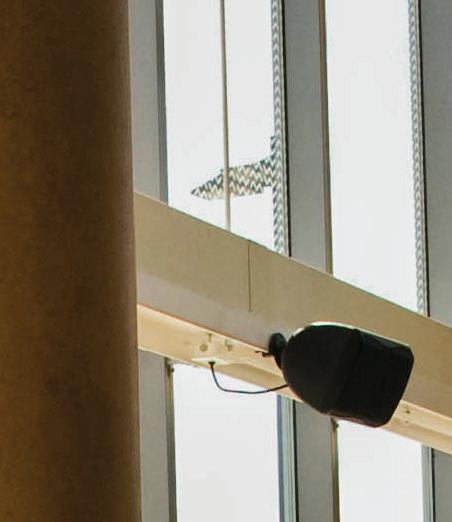





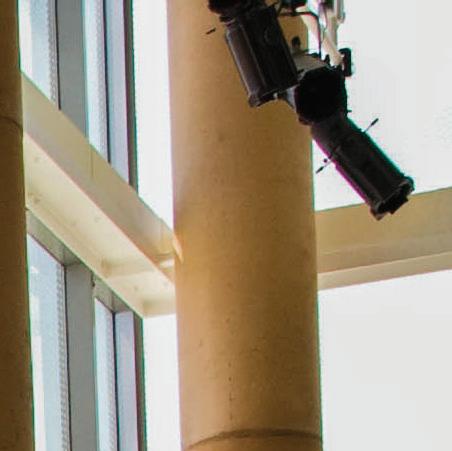








Greenheck
Greenheck’s Model DGX and Model MSX make-up air units with packaged direct expansion (PDX) have increased their cooling and airflow options in housing size H22. When configured with PDX, these units now offer airflow up to 9,000 cfm and have added cooling capacities at 7, 10, and 16 tons, expanding their range for make-up air applications. Both units use environmentally friendly, EPA-compliant R-454B refrigerant for PDX cooling, with chilled water and evaporative cooling as alternatives. The redesigned Model DGX with PDX provides direct gas-fired heat up to 1,200,000 Btu/h and incorporates microchannel coils, which are smaller, use less refrigerant, and transfer heat more efficiently. Model MSX is available with electric heat, steam coils, or hot water coils. www.greenheck.com/products/ air-conditioning/make-up-air
Aspen Manufacturing
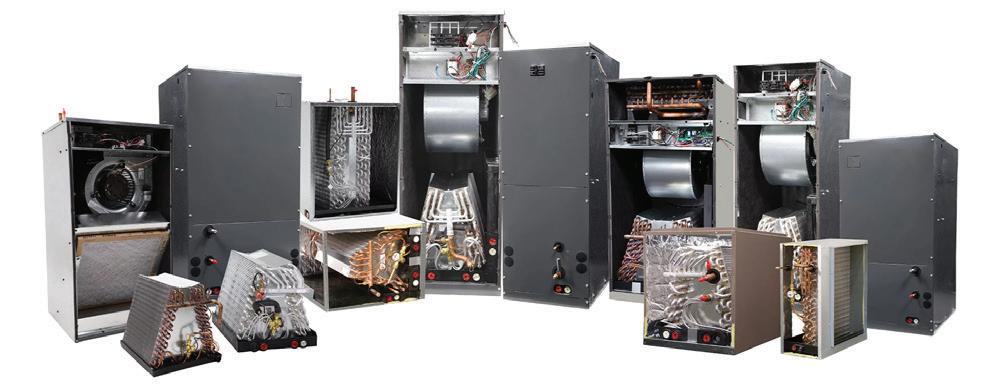
Aspen Manufacturing announced the availability of the new Versa Pro convertible coils and air handler systems. Aspen’s Versa Pro technology systems can be converted to use either R-32 or R-454B refrigerant. The dual refrigerant capability delivers unprecedented flexibility for both new and retrofit installations. Aspen is a wholly owned subsidiary of RectorSeal.
Versa Pro systems can be factory- or field-convertible to use either R-32 or R-454B refrigerant coupled with a proper metering device and a Refrigerant Detection System (RDS), providing outstanding installation flexibility. Designed with both performance and sustainability in mind, the Versa Pro systems feature robust construction with ETL certification, providing peace of mind regarding safety and compliance. www.rectorseal.com
Lochinvar
Lochinvar’s KNIGHT Fire Tube Boilers are manufactured with high-quality components, including a corrosion-resistant stainless steel fire-tube heat exchanger and a negative regulation combustion system. Additionally, each KNIGHT boiler is packaged with a variable-speed ECM circulator, which improves
day-to-day operational efficiency and can save up to 90% on operational costs. Lightweight with a compact footprint and easy-to-access components, the entire series is designed to make installation, setup and serviceability straightforward for contractors.
Every KNIGHT unit comes equipped with Lochinvar’s CON·X·US Remote Connect option and the LOCH-N-LINK USB Programming feature. The Set-Up Wizard guides contractors through installation, while CON·X·US allows a technician or homeowner to monitor and manage the boiler from a mobile app. www.lochinvar.com
Bosch Home Comfort

Bosch Home Comfort unveiled new R-454B versions of its Bosch CP Split Heat Pump and RP Split Heat Pump in compliance with low GWP A2L refrigerant requirements. The Bosch CP Split Heat Pump delivers powerful performance and flexible installation options for a wide range of commercial applications. The ENERGY STAR-certified Bosch RP Split Heat Pump is a premium, high-efficiency unit for residential applications. Homeowners who install the RP Split could qualify for rebates of up to 30% on the cost of installation.
Both heat pump units are available in 2-5 ton capacities, featuring a two-stage scroll compressor that adjusts output to demand for optimal comfort and efficiency. The heat pumps also feature a low-profile, compact footprint, making them an ideal choice for tight spaces; 1/2-inch close-cell foam insulation and a floating compressor base allow for operation at sound levels as low as 51dB; and either unit can be paired with the Bosch BV20 variable-speed air handler for optimal comfort, or the BMAC in duel-fuel applications. www.bosch-homecomfort.com/us

Allied Air Enterprises
Allied Air Enterprises introduces a groundbreaking addition to the MagicPak All-in-One M-Series, the MGE9. Ideal for multifamily and elderly care developments, the MagicPak M-Series MGE9 gas heating/electric cooling unit and through-the-wall application eliminates bulky outdoor equipment, maximizes usable square footage, and streamlines the installation process and workflow. MagicPak enables greater flexibility in architectural design and faster project completion.
The M-Series MGE9 features FreezeShield technology, which is engineered for reliability in extreme conditions. This exclusive
system features a sealed burner box, a patented heated condensate trap, and a patent-pending telescoping vent pipe—working together to prevent damaging ice formations that can lead to unit failure and costly emergency service calls. A high-efficiency 95% AFUE system, featuring a constant torque ECM blower motor and two-stage heating that adapts to demand: keeping residents cozy without the energy waste.
The through-the-Wall System installs in half the time, opening up an extra 5,400 square feet of property space, and eliminating bulky outdoor equipment. It eliminates 6,000 linear feet (more than a mile) of line sets, and also saves up to 500 project hours and up to $250,000 on installed costs, according to the company. www.magicpak.com
ABB
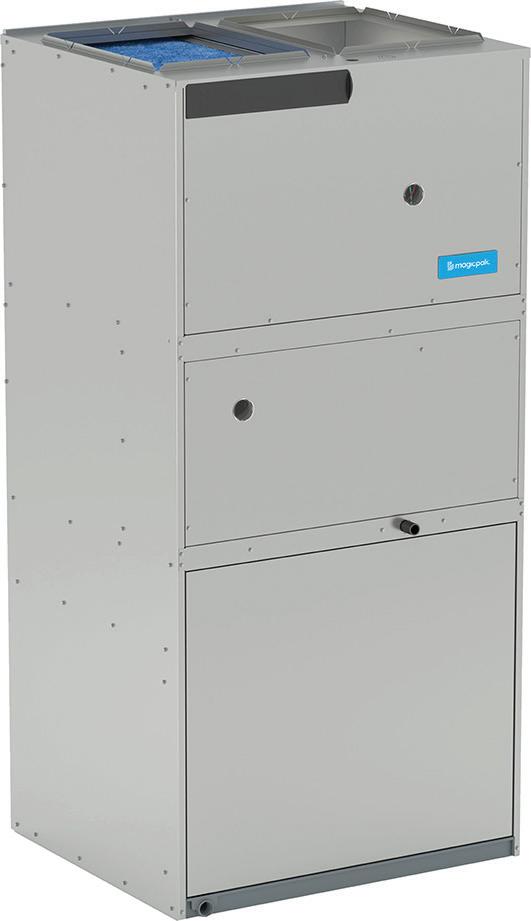
optimized for variable speed drive applications. With dual frequency support and a broad tri-voltage range, it operates seamlessly across a wide range of configurations without modifications.
Designed to operate seamlessly on both 50 Hz and 60 Hz power supplies, GNEM motors support tri-voltage configurations (208–230/460V at 60 Hz and 190/380V at 50 Hz), ensuring adaptability across diverse regions and power systems.

ABB’s globally compatible Baldor-Reliance GNEM (Global NEMA) motor is engineered to meet the diverse needs of industrial applications worldwide.
The GNEM motor is a high-performance, durable solution
Available in power ratings from 1 to 20 horsepower, covering NEMA frame sizes 56 through 286T, to suit a broad spectrum of industrial applications. Offered in both ODP and TEFC enclosures, in general purpose or HVACR (shaft grounded) configurations, with rugged cast-iron frames built to withstand demanding operating conditions, the motor is compliant with global Minimum Energy Performance Standards (MEPS), including NEMA Premium efficiency (IE3), ensuring energy savings, lower operating costs, and environmental compliance in both domestic and international markets. www.abb.com
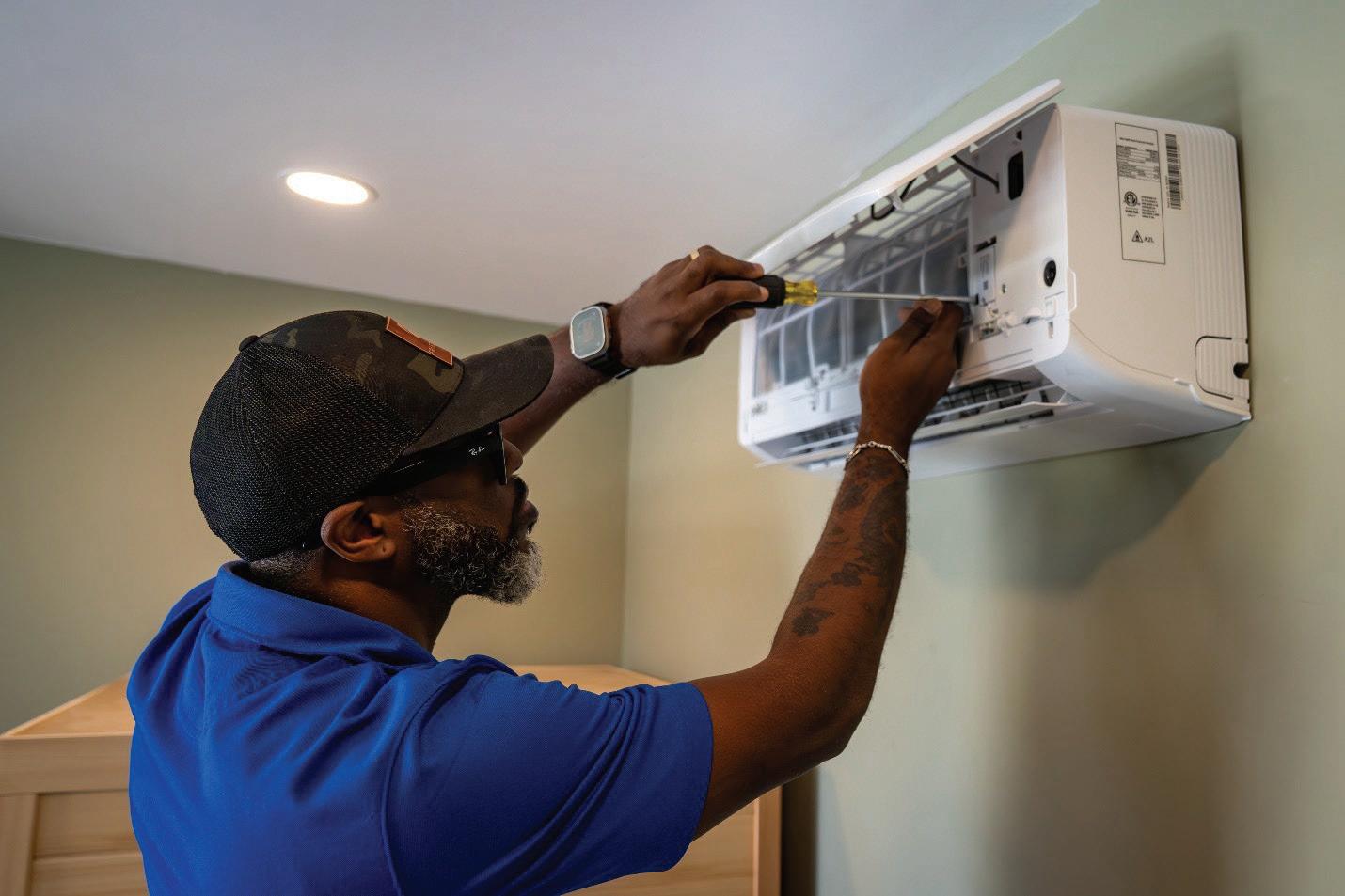

Continued from page 8
it is through serving as past president of WHVACR, INWIC, or being active with industry associations and councils. Those roles have given me the privilege of mentoring others, advocating for women in the trades, and working to change the optics of the industry so the next generation can see
themselves in it. And at the end of the day, HVAC matters. It directly impacts people’s comfort, safety, and quality of life, which makes everything we do meaningful.”
Sharrock has spent the last 13 years in the HVACR industry—his favorite part is building and developing leaders.
“Every day, I get to see the real difference our team makes for families in our
TN 37215;
Hills
37215
Owner - Full name and complete mailing address: Endeavor Media Holdings I, LLC, 905 Tower Place, Nashville, TN 37204; Endeavor Media Holdings II, LLC, 905 Tower Place, Nashville, TN 37204;Resolute Capital Partners Fund IV, LP, 20 Burton Hills Blvd, Suite 430, Nashville, TN 37215;RCP Endeavor, Inc, 20 Burton Hills Blvd, Suite 430, ,Nashville, TN 37215;Northcreek Mezzanine Fund II, LP,312 Walnut Street, Suite 2310,Cincinnati, OH 45202;Invegarry Holdings, LP,44235 Hillsboro Pike,Nashville, TN 37215;Everside Fund II, LP,155 East 44th St, Suite 2101 - 10 Grand Central,New York, NY 10017Everside Endeavor F1 Blocker, LLC, 155 East 44th St, Suite 2101 - 10 Grand Central, New York, NY 10017;Everside Endeavor International Blocker, LLC, 155 East 44th St, Suite 2101 - 10 Grand Central, New York, NY 10017;Everside Founders Fund, LP, 155 East 44th St, Suite 2101 - 10 Grand Central, ,New York, NY 10017;Suncap Endeavor
community—whether it’s restoring comfort, fixing an emergency, or providing peace of mind through our home plans,” he says. “One of the most rewarding parts of my role is investing in our people. Helping team members grow in their careers, find opportunities they didn’t see for themselves, and step into leadership. Jolly is on an exciting growth path, and being in the COO seat allows me to help shape the future of the company, ensuring we scale while keeping our culture and values intact. Jolly isn’t just about plumbing or HVAC it’s about reimagining a place where employees thrive, customers feel cared for, and the community benefits. That bigger mission is what pulls me in every single day.”
And last, but certainly not least, Jimoh has spent the last eight years in the home services industry, specifically in HVAC for the last two years.


“My favorite thing about working in the HVAC industry is hands down, the people,” she says. “While obviously complex, there is also such simplicity about the services we offer and the work being done. We get to connect with homeowners and the community in such a humble way that leads with service and the desire to help people. And I’m also curious about learning how consumers engage with the trades from a brand and marketing standpoint.”
These individuals will join legacy board members Tom Casey Jr., Mike Conley, Dominick Guarano, Brian Stack, and Matt Michel. You may see their names appearing within these pages every so often. I want to extend my heartfelt thanks to these individuals for their service to this magazine.
If you’re interested in learning more about the Editorial Advisory Board, or possibly participating, please reach out to me at nkrawcke@endeavorb2b.com.
Scott Sharrock, COO of Jolly Plumbing, Heating & Air Conditioning. Scott Sharrock
Jess Jimoh, marketing leader at Bonfe Plumbing, Heating, Cooling, Electrical & Sewer. Jess Jimoh
Air Conditioning Contractors of America 17 acca.org/awards
Cintas Corporation 18 cintas.com/contractingbus
Copeland 13 https://sensi.copeland.com/en-us
Daikin Comfort Technologies North America Inc. 36 www.r32ready.com
Fieldpiece Instruments Inc. 22 fieldpiece.com
FMHero 25 fmhero.com/facilityops
Greenheck 16 www.greenheck.com/
Griplock Systems, Llc 21 www.griplocksystems.com
International Exposition Company 7 https://www.ahrexpo.com/ Little Giant 15 littlegiant.com
Old World Industries, Inc. 9 thermalcharge.com Progressive Insurance 3 progressivecommerical.com
Rheem Heating & Cooling 5 rheem.com/floatingair
Rotobrush www.rotobrush.com
Shortridge Instruments, Inc 22, 24 www.shortridge.com supplyhouse.com 35 supplyhouse.com
Venstar Inc. 2 venstar.com
SALES CONTACTS
SOUTH & WEST: SENIOR MANAGER, BUSINESS DEVELOPMENT
Randy Jeter Office: 512-263-7280 Cell: 512-426-9145 Fax: 913-514-6628 rjeter@endeavorb2b.com
EAST COAST: SENIOR MANAGER, BUSINESS DEVELOPMENT
Brian Sack Cell: 732-629-1949 bsack@endeavorb2b.com
ACCOUNT MANAGER MIDWEST Bill Boyadjis 973-829-0648 bboyadjis@endeavorb2b.com
CLASSIFIEDS/INSIDE SALES: MEDIA ACCOUNT EXECUTIVE
Steve Suarez Cell: 816-588-7372 Office: 941-259-0867 ssuarez@endeavorb2b.com
DIRECTOR OF SALES, BUILDINGS & CONSTRUCTION GROUP Joe Agron 941-200-4778
jagron@endeavorb2b.com

You will wake up in 10 years no matter what. The question is whether you’ll wake up in a life and business you meant to build or one you built by accident.
Where Do You See Yourself in 10 Years?
Piggybacking off my “What Is a Mentor, Really?” column, I ran into one of my biggest mentors at the post office recently. When we first met, I was fresh out of college in my first “real” job—marketing for a health system. He was the CEO. Fifteen years later, he’s still one of the most influential mentors in my life.
We hadn’t talked in years, but I’ve always gone back to the lessons he taught me in that first job. When we caught up, I shared how our business has grown and asked if he’d be willing to help me think through what’s next. He agreed. And the very first thing he asked me, the first time we’d sat down in over a decade, has been echoing in my head ever since:
“Where do you want to be in 10 years?”
Simple question, right? I don’t think so. Most days, I’m just trying to make it to tomorrow. Ten years can feel like a lifetime away.
Then, this past weekend, perspective hit hard. My grandfather, another huge mentor in my life, entered hospice. As I sat with him, watching him sleep, I thought about the life he’s lived and the impact he’s had. He doesn’t have 10 years to set goals and reverseengineer them. He has days. My prayer is that he feels at peace with the life he built.
None of us knows how much time we have. But while we’re here, it’s on us to define our end goal. That’s the first step to building a life and business we actually want.
If you’re trying to answer the “10-year” question, here’s the thought process I’m using. Maybe it will help you, too.
Define Your Version of Success
What does success look like to you? Is it financial freedom? The number of people you help? The size or longevity of the business? What you can pass down to your family?
It’s easy to get swept up in social media and start chasing someone else’s finish line. That’s their journey, not yours. Be honest: do you actually want that, or do you feel like you’re supposed to want it? Live your truth. Name what would genuinely make you feel successful.
Get Real About Today
Alyssa Rogers is vice president of Rogers
Heating,
Cooling, Electrical, with offices in Lynchburg and South Boston, Virginia.
Every business needs a visionary. Visionaries dream big and sometimes lose touch with the starting line. Take a clear-eyed look at your current reality so you can build a realistic 10-year strategy.
• Financials: Where are your margins, pricing, and cash flow today? If you’re at $1M in revenue now and want to be at $100M in 10 years, that’s not a casual “we’ll see.”
• People: Do you have, or can you develop, the leaders who will carry this with you?
• Systems: Are your processes documented? Do you run the business by numbers, or by feel?
• Self: Are you doing the work to become the person who can lead at the next level?
Decide Who You’re Becoming
Do you imagine more freedom with your time? Beach trips with a drink in your hand? Front row at every PTA meeting? Becoming a stronger leader? Building a massive company? Your personal picture drives your business plan more than you think.
When my mentor asked me the question, the first image in my mind wasn’t a revenue target or a multibranch map. It was my daughter: her growth and me being present for it. That surprised me. I’ve always been very career-focused. My career still matters deeply, but the very first thing I saw was her, not a spreadsheet. That told me a lot about what my next 10 years should look like. So, ask yourself: What’s the first thing that comes to mind when you picture your life 10 years from now? Pay attention to that.
Reverse-Engineer It and Keep Refining
Now put it on paper.
• Write the vision. Describe your 10 year life and business in clear language;
• Build milestones backward. If this is Year 10, what must be true by Year 7? Year 5? Year 3? Year 1?
• Talk to your people. Share the vision with your family and your core team. Ask for their support and input;
• Create guardrails. Set a simple scorecard and a monthly cadence to review progress, adjust, and keep moving; and
• Be flexible. Life changes. Markets change. You’re allowed to tweak the destination and the route.
You’ll be amazed how your perspective shifts when the path is visible and shared.
Here’s my encouragement to you: you will wake up in 10 years no matter what. The question is whether you’ll wake up in a life and business you meant to build or one you built by accident.
Start with the end. Define success for you. Get clear about where you are today. Decide who you’re becoming. Then reverse engineer your way back to this week, this month, this year.
That’s how we move from “just trying to make it to tomorrow” to building the tomorrow we actually want.
EVERY HVAC BRAND FROM A-Z
ALMOST.
We’re missing 1 letter – but we have the other letters covered! Thousands of parts, complete with full 3D schematics and cross reference info, so you always know how a part fits into the larger unit.
We stay stocked and offer free 1–2-day shipping to 90% of the USA. Whether you’re working on a minor fix or a major overhaul, do less searching and more finding this HVAC season. And if you find a brand that begins with X, let us know.
Airzone
AprilAire
Arrco Air
Beckett Pumps
Bluefin
Broan
Carrier Comfort-Aire
Daikin DiversiTech
Honeywell Home
ICM Controls
iCool
Johnson Controls
KMC Controls
Lennox
LG
LifeBreath
Little Giant
MARS
Navac
Nu-Calgon
Oxbox
Panasonic
QMark
Rectorseal
Resideo
Rheem
R.W. Beckett
Santa Fe
Supco
Tekmar
Testo
Trane
US Motors
Venstar
White Rodgers
York
Z-Flex + MORE!
Check out our HVAC products!
Use code HVAC5 for 5% OFF your first order!
